History of the Southern United States
| This article is part of a series on the |
| History of the United States |
|---|
 |

The history of the Southern United States spans back thousands of years to the first evidence of human occupation. The Paleo-Indians were the first peoples to inhabit the Americas and what would become the Southern United States. By the time Europeans arrived in the 15th century, the region was inhabited by the Mississippian people, well known for their mound-building cultures, building some of the largest cities of the Pre-Columbian United States. European history in the region would begin with the earliest days of the exploration. Spain, France, and especially England explored and claimed parts of the region.
Starting in the 17th century, the history of the Southern United States developed unique characteristics that came from its economy based primarily on plantation agriculture and the ubiquitous and prevalent institution of slavery. While West Africans were brought to the region as soon as English colonization began, the system was strictly formalized after Bacon's Rebellion. Afterwards, Millions of enslaved Africans, approximately 10% of all slaves taken from Africa during the Trans-Atlantic Slave Trade were imported to the United States primarily but not exclusively for forced labor in the south. While the great majority of Whites did not own slaves, slavery was nevertheless the foundation of the region's economy and social order. Southern slavery denied basic human rights to Black Americans and permeated all parts of daily life of all residents. Questions of Southern slavery directly impacted the struggle for American independence throughout the South gave the region additional power in Congress. Almost all Southern founding fathers owned slaves including Thomas Jefferson and George Washington, though Washington did free all enslaved persons in his will.
As industrial technologies including the cotton gin made slavery even more profitable, Southern states refused to ban slavery- perpetuating the division of the United States between free and slave states. Tensions escalated as the United States expanded west ward (also retroactively causing the Southeast region to also expand to the west. However, tepid agreements including the Missouri Compromise and the Compromise of 1850 did not resolve the growing divisions the South had with the North due to slavery and the planter class's political aspirations to control the entire country. Abraham Lincoln's election in 1860 caused South Carolina to secede which was soon followed by all other states in the region with the exception of the 'border states'. The breakaway states formed the Confederate States of America – the most significant country in modern history worldwide that was founded for the purpose of promoting slavery.
Lincoln's original goal was only to preserve the United States but to do that he had to destroy the Confederacy's economic base: slavery. Therefore his Emancipation Proclamation brought freedom to Black slaves living in rebellious areas as soon as the US Army arrived. With a smaller economy, smaller population and (in some cases) widespread dissent among its white population the Confederate States of America was unable to carry on a protracted struggle with the national government. The 13th and 14th amendments gave freedom, citizenship and civil rights to Black Americans all across the United States. The 15th Amendment and Radical reconstruction laws gave Black men the vote, and for a few years they shared power in the South, despite violent attacks by the Ku Klux Klan. Reconstruction attempted to uplift the former enslaved but this crusade was abandoned in the Compromise of 1877 and Conservative white Southerners calling themselves Redeemers took control. Even though the Ku Klux Klan was suppressed new White Supremacist organizations including the Red Shirts and the White League continued to terrorize Black Americans.
After the dissolving of a Populist movement in the 1890s that attempted to unite working-class blacks and whites Segregation and Jim Crow laws were implemented all across the region by 1900. Compared to the North, the Southern United States lost its previous political and economic power and fell behind the rest of the United States for decades. Its agricultural economy was often based on Sharecropping practices. The New Deal and World War II brought about a generation of Liberal Southerners within the Democratic Party that looked to accelerate development. The white South had a strong voice in Congress, which reorganized the cotton and tobacco markets to the advantage of Southern farmers. The government-operated Tennessee Valley Authority brought electricity and modernization to that state. Yet in exchange for economic reforms the progressive New Deal coalition carried an uneasy compromise with segregationist Democrats that the Jim Crow system would be left unaltered and the denial of basic civil rights to Black Americans would continue. Years after President Franklin D. Roosevelt died his Supreme Court appointees started dismantling segregation in the 1950s.
Black Americans and their allies resisted Jim Crow and Segregation, initially with the Great Migration and later the civil rights movement. In the face of intense opposition by racist Segregationists, Black Southerners including Martin Luther King Jr, Rosa Parks and others in a multi-racial coalition vigorously campaigned to end institutionalized racism in the American South as well as the rest of the United States. From a political and legal standpoint, many of these aims were realized by the Supreme Court's ruling on Brown v. Board and President Lyndon Johnson's (also a Southerner) reforms. Civil Rights coupled with the collapse of Black Belt agriculture has led some historians to postulate that a 'New South' based on Free Trade, Globalization, and cultural diversity has emerged. Meanwhile, the South has influenced the rest of the United States in a process called Southernization. The legacy of Slavery and Jim Crow continue to impact the region- which by the 21st century was the most populous area of the United States.[1]
Native American civilizations until 1730
[edit]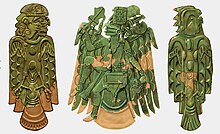
Indigenous peoples of the Southeastern Woodlands, Southeastern cultures, or Southeast Indians are an ethnographic classification for Native Americans who have traditionally inhabited the area now part of the Southeastern United States and the northeastern border of Mexico, that share common cultural traits. This classification is a part of the Eastern Woodlands. The concept of a southeastern cultural region was developed by anthropologists, beginning with Otis Mason and Franz Boas in 1887. The boundaries of the region are defined more by shared cultural traits than by geographic distinctions.[2]
Paleo-Indians
[edit]Around 20,000 years ago during the Last Glacial Maximum and its aftermath the first humans likely arrived in the Southern United States.[3] The entire region had a climate and geography that differed remarkably from current conditions. Overall the region was not only colder but much drier. On average the coastline extended at least 50 miles out into the ocean, most of which would have had a patchy maritime Boreal forest adapted to colder conditions. Meanwhile much of the interior South had a taiga forest comparable to the Canadian Yukon and the Northwest Territories. The Floridian peninsula was much larger and was mostly a temperate savanna. Further west almost the whole of Texas consisted of a tropical desert.[4] However there were also times in prehistory where the South did not adhere to global conditions; for instance during the Younger Dryas Ice Age 11,000 years ago the region became more warm and wet whereas the rest of North America became colder.[5]
There is debate among archeologists and historians over the exact when the Peopling of the Americas and by extension the American Southeast took place. Cactus Hill near Richmond, Virginia may be one of the oldest archaeological sites in the Americas. If proven to have been inhabited 16,000 to 20,000 years ago, it would provide supporting evidence for pre-Clovis occupation of the Americas.[3] The first well-dated evidence of human occupation in the south United States occurs around 9500 BC with the appearance of the earliest documented Americans, who are now referred to as Paleo-Indians.[6] Paleoindians were hunter-gatherers that roamed in bands and frequently hunted megafauna including Wooly Mammoth and Giant short-faced bears.[7]
Mound builders
[edit]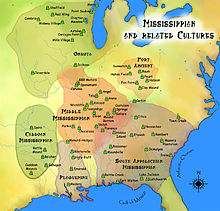
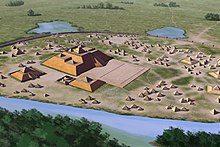
Several cultural stages, such as Archaic (c. 8000–1000 BC), Poverty Point, and the Woodland (c. 1000 BC – AD 1000), preceded what the Europeans found at the end of the 15th century – the Mississippian culture. Many pre-Columbian cultures in North America were collectively termed "Mound Builders", but the term has no formal meaning. It does not refer to specific people or archaeological culture but refers to the characteristic mound earthworks that indigenous peoples erected for an extended period of more than 5,000 years.
Mound builders were originally thought to be exclusively agricultural however early mounds found in Louisiana preceded such cultures and were products of hunter-gatherers. The first mound building was an early marker of political and social complexity among the cultures in the Eastern United States. Watson Brake in Louisiana, constructed about 3500 BCE during the Middle Archaic period, is the oldest known and dated mound complex in North America. It is one of 11 mound complexes from this period found in the Lower Mississippi Valley.[8]
The namesake cultural trait of the Mound Builders was the building of mounds and other earthworks. These burial and ceremonial structures were typically flat-topped pyramids or platform mounds, flat-topped or rounded cones, elongated ridges, and sometimes a variety of other forms. They were generally built as part of complex villages. These cultures generally had developed hierarchical societies that had an elite. These commanded hundreds or even thousands of workers to dig up tons of earth with the hand tools available, move the soil long distances, and finally, workers to create the shape with layers of soil as directed by the builders.[9]
By the 15th century, much of the area had been home to several regional variants of the Mississippian culture for centuries, an agrarian culture that flourished in the Midwestern, Eastern, and Southeastern United States. The Mississippian way of life began to develop around the 10th century in the Mississippi River Valley (for which it is named).The Mississippian culture was a complex, Native American culture that flourished in what is now the Southeastern United States from approximately 800 AD to 1500 AD.[10] Among these cities Cahokia by St. Louis, was significant and the trading network was extensive; Etowah was a large walled city built close to the location of modern-day Atlanta. Natives had elaborate and lengthy trading routes connecting their main residential and ceremonial centers extending through the river valleys and from the East Coast to the Great Lakes, however the vast majority of mounds were concentrated in what would later become known as the Deep South. Prior to European contact, some Mississippian cultures were experiencing severe social stress as warfare increased and mound construction slowed or in other cases stopped completely, the societal decline was possibly caused by the Little Ice Age.[11]
Post Contact
[edit]
The Mississippian shatter zone describes the period from 1540 to 1730 in the southeastern part of the present United States. During that time, the interaction between European explorers and colonists transformed the Native American (Indian) cultures of that region. In 1540 dozens of chiefdoms and several paramount chiefdoms were scattered throughout the southeast. Chiefdoms featured a noble class ruling a large number of commoners and were characterized by villages and towns with large earthen mounds and complex religious practices. Some noted explorers who encountered and described the culture, by then in decline, included Pánfilo de Narváez (1528), Hernando de Soto (1540), and Pierre Le Moyne d'Iberville (1699).
The chiefdoms all disappeared by 1730. The most important factor in their gradual disappearance was the chaos induced by slave raids and the enslavement of tens of thousands of Indians. Other factors included epidemics of diseases of European origin and wars among themselves and with European colonists. Indian slaves usually ended up working on plantations in the U.S. or were exported to islands in the Caribbean Sea. The city of Charleston, South Carolina was the most important slave market. The Indian population in the southeast decreased from an estimated 500,000 in 1540 to 90,000 in 1730. The chiefdoms were replaced by simpler coalescent tribes and confederacies made up of survivors and refugees from the fragmenting nations.[12]
Native American descendants of the mound-builders include Alabama, Apalachee, Caddo, Cherokee, Chickasaw, Choctaw, Creek, Guale, Hitchiti, Houma, and Seminole peoples, all of whom still reside in the South.[13] Other peoples whose ancestral links to the Mississippian culture are less clear but were clearly in the region before the European incursion include the Catawba and the Powhatan.[10]
European colonization (1519–1821)
[edit]Spanish exploration and colonization
[edit]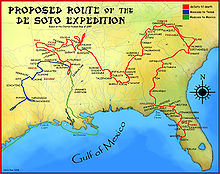
Spain made frequent exploratory trips to the New World after its discovery in 1492. Rumors of natives being decorated with gold and stories of a Fountain of Youth helped hold the interest of many Spanish explorers. Juan Ponce de León was the first European to come to the South when he landed in Florida in 1513. Alonso Álvarez de Pineda was the first European to see the Mississippi river, in 1519 when he sailed twenty miles up the river from the Gulf of Mexico.[14]
Hernando de Soto, a Spanish explorer and conquistador led the first European expedition deep into the territory, searching for gold, and a passage to China.[15] A vast undertaking, de Soto's North American expedition ranged across parts of the modern states of Florida, Georgia, South Carolina, North Carolina, Tennessee, Alabama, Mississippi, Arkansas, Louisiana, and Texas.[14]
Among the first European settlements in North America were Spanish settlements in Florida; the earliest was Tristán de Luna y Arellano's failed colony in what is now Pensacola in 1559. More successful was Pedro Menéndez de Avilés's St. Augustine, founded in 1565. Most of the Spanish left when Florida was turned over to Britain in 1763. St. Augustine remains the oldest continuously inhabited European settlement in the continental United States. Spain also colonized parts of Alabama, Mississippi, Louisiana, and Texas.

Spanish Texas was one of the interior provinces of the colonial Viceroyalty of New Spain from 1519 until 1821 but the first Spanish settlers arrived in 1716 They operated several missions and a presidio to maintain a buffer between Spanish territory and the Louisiana district of New France. San Antonio was founded in 1719 and became the capital and largest settlement of Spanish Tejas. The Lipan Apache menaced the newly founded colony until 1749 when the Spanish and Lipan concluded a peace treaty. Both the Spanish and Lipan were then threatened by Comanche raids until 1785 when the Spanish and Comanche negotiated a peace agreement.
French colonization
[edit]The first French settlement in what is now the Southern United States was Fort Caroline, located in what is now Jacksonville, Florida, in 1562. It was established as a haven for the Huguenots and was destroyed by the Spanish in 1565.
Later French arrived from the north. Having established agricultural colonies in Canada and built a fur trading network with Indians in the Great Lakes area, they began to explore the Mississippi River. The French called their territory Louisiana, in honor of their King Louis. France claimed Texas and set up several short-lived forts there, such as the one in Red River County, built in 1718. In 1817 the French pirate Jean Lafitte settled on Galveston Island; his colony there grew to more than 1,000 persons by 1818 but was abandoned in 1820. The most important French settlements were established at New Orleans and Mobile (originally called Bienville). Only a few settlers came from France directly, with others arriving from Haiti and Acadia.[16]
British colonial era (1585–1775)
[edit]
First Colonies
[edit]Just before they defeated the Spanish Armada, the English began exploring the New World. In 1585, an expedition organized by Walter Raleigh established the first English settlement in the New World, on Roanoke Island, North Carolina. The colony failed to prosper, however, and the colonists were retrieved the following year by English supply ships. In 1587, Raleigh again sent out a group of colonists to Roanoke. From this colony, the first recorded European birth in North America, a child named Virginia Dare, was reported. That group of colonists disappeared and is known as the "Lost Colony". Many people theorize that they were either killed or taken in by local tribes.[17]
Like New England, the South was originally settled by English Protestants. While the earlier attempt at colonization had failed on Roanoke Island, the English established their first permanent colony in America in Jamestown, Virginia, in 1607, at the mouth of the James River, which in turn empties into Chesapeake Bay.[18]

Settlement of Chesapeake Bay was driven by a desire to obtain precious metal resources, specifically gold. The colony was technically still within Spanish territorial claims, yet far enough from most Spanish settlements to avoid colonial clashes. As the "Anchor of the South", the region includes the Delmarva Peninsula and much of coastal Virginia, Maryland, North Carolina, South Carolina, and Georgia.
Early in the history of the colony, it became clear that the claims of gold deposits were vastly exaggerated. Referred to as the "Starving Time" of the Jamestown colony, the years from the time of landing in 1607 until 1609 were rife with famine and instability. However, Native American support, in addition to reinforcements from Britain, sustained the small colony. Due to continued political and economic instability, however, the charter of the Colony of Virginia was revoked in 1624. The primary cause of this revocation was the revelation that hundreds of settlers were dead or missing following an attack in 1622 by Native American tribes led by Opechancanough. A royal charter was established for Virginia, yet the House of Burgesses, formed in 1619, was allowed to continue as political leadership for the colony in conjunction with a royal governor.[19]

George Calvert, 1st Baron Baltimore, applied to Charles I for a royal charter for what was to become the Province of Maryland. After Calvert died in April 1632, the charter for "Maryland Colony" (in Latin Terra Mariae) was granted to his son, Cecilius Calvert, 2nd Baron Baltimore, on June 20, 1632.[20] Some historians viewed this as compensation for his father having been stripped of his title of Secretary of State in 1625 after announcing his Roman Catholicism. Maryland soon became one of the few predominantly Catholic regions among the English colonies in North America. Maryland was also one of the key destinations where the government sent tens of thousands of English convicts punished by sentences of transportation. Such punishment persisted until the Revolutionary War.
The Province of North Carolina developed differently from South Carolina almost from the beginning. The Spanish experienced trouble colonizing North Carolina because it had a dangerous coastline, a lack of ports, and few inland rivers by which to navigate. In the 1650s and 1660s, settlers (mostly English) moved south from Virginia, in addition to runaway servants and fur trappers. They settled chiefly in the Albemarle borderlands region.[21]
In 1665, the Crown issued a second charter to resolve territorial questions. As early as 1689, the Carolina proprietors named a separate deputy-governor for the region of the colony that lay to the north and east of Cape Fear. The division of the province into North and South became official in 1712.
Life and Society in the 17th Century
[edit]

A key figure in the region's political and cultural development was William Berkeley, who served, with some interruptions, as governor of Virginia from 1645 until 1675. His desire for an elite immigration to Virginia led to the "Second Sons" policy, in which younger sons of English aristocrats were recruited to emigrate to Virginia.[22] Berkeley also emphasized the headright system, the offering of large tracts of land to those arriving in the colony. This early immigration by an elite contributed to the development of an aristocratic political and social structure in the South.[23]
English colonists, especially young indentured servants, continued to arrive along the southern Atlantic coast. Virginia became a prosperous English colony. During this period, life expectancy was often low, and indentured servants came from overpopulated European areas. With the lower price of servants compared to slaves, and the high mortality of the servants, planters often found it much more economical to use servants.
Bacon's Rebellion was an unsuccessful armed rebellion by some Virginia settlers that took place from 1676 to 1677. It was led by Nathaniel Bacon against Governor Berkeley, after he refused Bacon's demand to drive Native American Indians out of Virginia. Thousands of Virginians from all races and classes (including those in indentured servitude) rose up in arms against Berkeley, chasing him from Jamestown and ultimately torching the settlement. The rebellion was first suppressed by a few armed merchant ships from London whose captains sided with Berkeley and the loyalists.[24] Government forces arrived soon after and spent several years defeating pockets of resistance and reforming the colonial government to be once more under direct Crown control.[25]
Edmund S. Morgan's 1975 classic, American Slavery, American Freedom: The Ordeal of Colonial Virginia, connected the threat of Bacon's Rebellion, namely the potential for lower-class revolt, with the colony's transition over to slavery, saying, "But for those with eyes to see, there was an obvious lesson in the rebellion. Resentment of an alien race might be more powerful than resentment of an upper class. Virginians did not immediately grasp it. It would sink in as time went on."[26]
Rise of tobacco culture and slavery in the colonial South
[edit]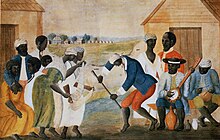
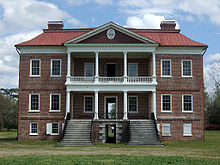
From the introduction of tobacco in 1613, its cultivation began to form the basis of the early Southern economy. Cotton did not become a mainstay until much later, after technological developments, especially the Whitney cotton gin of 1794, greatly increased the profitability of cotton cultivation. Until that point, most cotton was farmed in large plantations in the Province of Carolina, and tobacco, which could be grown profitably in farms of smaller scale, was the dominant cash crop export of the South and the Middle Colonies. In 1640, the Virginia General Court recorded the earliest documentation of lifetime slavery when it sentenced John Punch to lifetime servitude under his master Hugh Gwyn for running away.[29][30]
Much of the slave trade was conducted as part of the "triangular trade", a three-way exchange of slaves, rum, and sugar. Northern shippers purchased slaves using rum, made in New England from cane sugar, which was in turn grown in the Caribbean. This slave trade was generally able to fulfill labor needs in the South for the cultivation of tobacco after the decline of indentured servants. At approximately the point when tobacco labor needs began to increase, the mortality rate fell and all groups lived longer. By the late 17th century and early 18th century, slaves became economically viable sources of labor for the growing tobacco culture. Also, further south than the Mid-Atlantic, Southern settlers grew wealthy by raising and selling rice, indigo, and cotton. The plantations of South Carolina often were modeled on Caribbean plantations, albeit smaller in size.[31]
Throughout British North America, slavery evolved in practice before it was codified into law. The Barbados slave code of 1661 marked the beginning of the legal codification of slavery. According to historian Russell Menard, "Since Barbados was the first English colony to write a comprehensive slave code, its code was especially influential."[32] The Barbados Slave Code served as the basis for the slave codes adopted in several other British American colonies, including Jamaica, Carolina (1696), Georgia, and Antigua. In other colonies where the codes are not an exact copy, such as Virginia and Maryland, the influence of the Barbados Slave Code can be traced throughout various provisions.[32][33][34]
Slavery in the early colonial period differed in the North American colonies from that in the Caribbean, such as the British West Indies. Caribbean slaves were often worked literally to death on large sugar and rice plantations, while the American slave population had a higher life expectancy and was maintained through natural reproduction. This natural reproduction was important for the continuation of slavery after the prohibition on slave importation in 1808.[35]
Slavery in the Colonial period was not without resistance, the most notable rebellion in the Southern Colonies was the Stono Rebellion. Portuguese speaking Angolans in the lowcountry of South Carolina, with prior military training attempted to escape to Catholic Spanish Florida. The rebellion however was intercepted by the South Carolina militia and almost all were executed, others were sold and sent to the West Indies. The rebellion profoundly changed slavery in South Carolina, the Negro Act of 1740 placed harsh regulations on slaves, including a provision that allowed any White colonist to inspect any slave for any reason. Some attempts were made to improve working conditions but these were mostly fruitless as no slave could testify against any whites. There were later revolts as well, provoked by the oppression of slavery.[36]
The 18th century Southern colonies
[edit]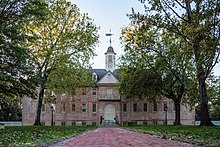
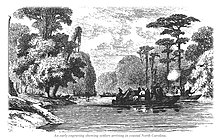

For details on each specific colony, see Province of Georgia, Province of Maryland, Province of North Carolina, Province of South Carolina, and Colony of Virginia.
By the end of the 17th century, the number of colonists was growing. The economies of the Southern colonies were tied to agriculture. During this time the great plantations were formed by wealthy colonists who saw great opportunity in the new country. Tobacco and cotton were the main cash crops of the areas and were readily accepted by English buyers. Rice and indigo were also grown in the area and exported to Europe. The plantation owners built a vast aristocratic life and accumulated a great deal of wealth from their land. They relied on slavery as a means of working their land. On the other side of the agricultural coin were the small yeoman farmers. They did not have the capability or wealth to operate large plantations. Instead, they worked small tracts of land to feed themselves and trade locally, and grow some tobacco. They developed a political activism in response to the growing oligarchy of the plantation owners. Many politicians from this era were yeoman farmers speaking out to protect their rights as free men.[38]
Charleston became a booming trade town for the southern colonies. The abundance of pine trees in the area provided raw materials for shipyards to develop, and the harbor provided a safe port for English ships bringing in imported goods. The colonists exported tobacco, indigo and rice and imported tea, sugar, and slaves.
After the late 17th century, the economies of the North and the South began to diverge, especially in coastal areas. The Southern emphasis on export production contrasted with the Northern emphasis on food production.
Further south British General James Oglethorpe envisioned Georgia as a colony which would serve as a haven for English subjects who had been imprisoned for debt and "the worthy poor". General Oglethorpe imposed very strict laws that many colonists disagreed with, such as the banning of alcoholic beverages.[39] He disagreed with slavery and thought a system of smallholdings more appropriate than the large plantations common in the colonies just to the north. However, land grants were not as large as most colonists would have preferred.
Another reason for the founding of the colony was as a buffer state and a "garrison province" which would defend the southern British colonies from Spanish Florida. Oglethorpe imagined a province populated by "sturdy farmers" who could guard the border; because of this, the colony's charter prohibited slavery.[40] The ban on slavery was lifted by 1751 and the colony became a royal colony by 1752.[41]
By the mid-18th century, the colonies of Maryland, Delaware, Virginia, North Carolina, South Carolina, and Georgia had been established. In the upper colonies, that is, Maryland, Virginia, and portions of North Carolina, the tobacco culture prevailed. However, in the lower colonies of South Carolina and Georgia, cultivation focused more on cotton and rice.
American Revolution (1775–1789)
[edit]

Revolutionary War
[edit]Some southern colonies, led by Virginia, gave support for the Patriot cause in solidarity with Massachusetts. Georgia, the newest, smallest, most exposed and militarily most vulnerable colony, hesitated briefly before joining the other 12 colonies in Congress. South Carolina meanwhile had the largest loyalist support of any state, usually from the backcountry or 'upland'. As soon as news arrived of the Battles of Lexington and Concord in April 1775, Patriot forces took control of every colony, using secret committees that had been organized in the previous two years.[42] After the combat began, Governor Dunmore of Virginia was forced to flee to a British warship off the coast. In late 1775 he issued a proclamation offering freedom to slaves who escaped from Patriot owners and volunteer to fight for the British Army. Over 1,000 volunteered and served in British uniforms, chiefly in the Ethiopian Regiment. However, they were defeated in the Battle of Great Bridge, and most of them died of disease. The Royal Navy took Dunmore and other officials home in August 1776, and also carried to freedom 300 surviving former slaves.[43]
Southern politicians were at the forefront in the early Continental Congresses and the writing of The Declaration of Independence. Thomas Jefferson wrote the first draft; Jefferson's draft condemned the United Kingdom for bringing slaves to North America despite being a slaveowner himself. Other delegates insisted on removal of any mention of slavery from the document. South Carolina's delegation ensured the continuance of the institution of slavery. Delegate Thomas Lynch threatened to break away from the country if congress entertained any discussion on slavery, indicating that for South Carolina preserving slavery was more important than American nationhood.[44] Meanwhile Edward Rutledge tried unsuccessfully to expel black soldiers from the Continental Army[45]

After their defeat at Saratoga in 1777 and the entry of the French into the American Revolutionary War, the British turned their attention to the South. With fewer regular troops at their disposal, the British commanders developed a "southern strategy" that relied heavily on volunteer soldiers and militia from the Loyalist element.[46]
Beginning in late December 1778, the British captured Savannah and controlled the Georgia coastline. In 1780 they seized Charleston, capturing a large American army. A significant victory at the Battle of Camden meant that royal forces soon controlled most of Georgia and South Carolina. The British set up a network of forts inland, expecting the Loyalists would rally to the flag. Far too few Loyalists turned out however, and the British had to fight their way north into North Carolina and Virginia with a severely weakened army. Behind them most of the territory they had already captured dissolved into a chaotic guerrilla war, fought predominantly between bands of Loyalist and Patriot militia, with the Patriots retaking the areas the British had previously gained.[47] In January 1781, the Battle of Cowpens near Cowpens, South Carolina, was a turning point in the American reconquest of South Carolina from the British.
The British army marched to Yorktown, Virginia, where they expected to be rescued by a British fleet. The fleet showed up but so did a larger French fleet, so the British fleet after the Battle of the Chesapeake returned to New York for reinforcements, leaving General Cornwallis trapped by the much larger American and French armies under Washington. He surrendered. The most prominent Loyalists, especially those who joined Loyalist regiments, were evacuated by the Royal Navy back to England, Canada, or other British colonies; they brought their slaves along, but lost their land. The other Loyalists who remained in the southern states became American citizens.[48]
The South influences the new nation
[edit]
After the upheaval of the American Revolution effectively came to an end at the Siege of Yorktown (1781), the South became a major political force in the development of the United States. With the ratification of the Articles of Confederation, the South found political stability and a minimum of federal interference in state affairs. However, with this stability came a weakness in its design, and the inability of the Confederation to maintain economic viability eventually forced the creation of the United States Constitution in Philadelphia in 1787. Importantly, Southerners of 1861 often believed their secessionist efforts and the Civil War paralleled the American Revolution, as a military and ideological "replay" of the latter.
Southern leaders were able to protect their sectional interests during the Constitutional Convention of 1787, preventing the insertion of any explicit anti-slavery position in the Constitution. Moreover, they were able to force the inclusion of the "fugitive slave clause" and the "Three-Fifths Compromise". Nevertheless, Congress retained the power to regulate the slave trade. Twenty years after the ratification of the Constitution, the law-making body prohibited the importation of slaves, effective January 1, 1808. While North and South were able to find common ground to gain the benefits of a strong Union, the unity achieved in the Constitution masked deeply rooted differences in economic and political interests. After the 1787 convention, two discrete understandings of American republicanism emerged.
In the South, agrarian laissez-faire formed the basis of political culture. Led by Thomas Jefferson and James Madison, this agrarian position is characterized by the epitaph on the grave of Jefferson. While including his "condition bettering" roles in the foundation of the University of Virginia, and the writing of the Declaration of Independence and the Virginia Statute for Religious Freedom, absent from the epitaph was his role as President of the United States. The development of Southern political thought thus focused on the ideal of the yeoman farmer; i.e., those who are tied to the land also have a vested interest in the stability and survival of the government.[49]
The Revolution provided a shock to slavery in the South and other regions of the new country. Thousands of slaves took advantage of wartime disruption to find their own freedom, catalyzed by the British Governor Dunmore of Virginia's promise of freedom for service. Many others were removed by Loyalist owners and became slaves elsewhere in the British Empire. Between 1770 and 1790, there was a sharp decline in the percentage of blacks – from 61% to 44% in South Carolina and from 45% to 36% in Georgia.[50] In addition, some slaveholders were inspired to free their slaves after the Revolution. They were moved by the principles of the Revolution, along with Quaker and Methodist preachers who worked to encourage slaveholders to free their slaves. Planters such as George Washington often freed slaves by their wills. In the Upper South, more than 10% of all blacks were free by 1810, a significant expansion from pre-war proportions of less than 1% free.[51]
Antebellum era (1789–1861)
[edit]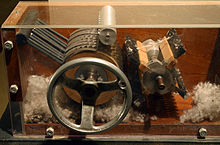

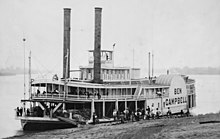
From a cultural and social standpoint, the "Old South" is used to describe the rural, agriculturally-based, slavery-reliant economy and society in the Antebellum South, prior to the American Civil War (1861–65),[52] in contrast to the "New South" of the post-Reconstruction Era.
The social structure of the Old South was made an important research topic for scholars by Ulrich Bonnell Phillips in the early 20th century.[53] The romanticized image of the "Old South" tells of slavery's plantations, as famously typified in Gone with the Wind, a blockbuster 1936 novel and its adaptation in a 1939 Hollywood film, along with other popular media portrayals. Historians in recent decades have paid much more attention to the enslaved people of the South and the world they made for themselves.[54][55] To a lesser extent, they have also studied the poor subsistence farmers, known as "yeoman farmers", who owned little property and no slaves.[56]
There were almost 700,000 enslaved persons in the U.S. in 1790, which equated to approximately 18 percent of the total population, or roughly one in every six people. This had persisted through the 17th and 18th centuries, but the invention of the cotton gin by Eli Whitney in the 1790s made slavery even more profitable and caused a larger plantation system developed. In the 15 years between the invention of the cotton gin and the passage of the Act Prohibiting Importation of Slaves, an increase in the slave trade occurred, furthering the slave system in the United States.[57]
As the country expanded its territory and economy west, New Orleans was the third largest American city in population by 1840. The success of the city was based on the growth of international trade associated with products being shipped to and from the interior of the country down the Mississippi River. New Orleans also had the largest slave market in the country, as traders brought slaves by ship and overland to sell to planters across the Deep South. The city was a cosmopolitan port with a variety of jobs that attracted more immigrants than other areas of the South. Because of lack of investment, however, construction of railroads to span the region lagged behind the North. People relied most heavily on river traffic for getting their crops to market and for transportation.
Jacksonian democracy was a 19th-century political philosophy in the United States that expanded suffrage to most white men over the age of 21 and restructured a number of federal institutions. Originating with the seventh U.S. president, Andrew Jackson and his supporters, it became the nation's dominant political worldview for a generation. The term itself was in active use by the 1830s.[58]
This era, called the Jacksonian Era or Second Party System by historians and political scientists, lasted roughly from Jackson's 1828 election as president until slavery became the dominant issue with the passage of the Kansas–Nebraska Act in 1854 and the political repercussions of the American Civil War dramatically reshaped American politics. It emerged when the long-dominant Democratic-Republican Party became factionalized around the 1824 United States presidential election. Jackson's supporters began to form the modern Democratic Party.
Broadly speaking, the era was characterized by a democratic spirit. It built upon Jackson's equal political policy, subsequent to ending what he termed a monopoly of government by elites. Even before the Jacksonian era began, suffrage had been extended to a majority of white male adult citizens, a result which the Jacksonians celebrated.[59] Jacksonian democracy also promoted the strength of the presidency and the executive branch at the expense of the United States Congress, while also seeking to broaden the public's participation in government. The Jacksonians demanded elected, not appointed, judges and rewrote many state constitutions to reflect the new values. In national terms, they favored geographical expansionism, justifying it in terms of manifest destiny. There was usually a consensus among both Jacksonians and Whigs that battles over slavery should be avoided.
Indian removal
[edit]
In 1830, Congress passed the Indian Removal Act, which authorized the president to negotiate treaties that exchanged Native American tribal lands in the eastern states for lands west of the Mississippi River.[60] Its goal was primarily to remove Native Americans, including the Five Civilized Tribes, from the American Southeast – they occupied land that settlers wanted.[61]
Jacksonian Democrats demanded the forcible removal of native populations who refused to acknowledge state laws to reservations in the West. Whigs and religious leaders opposed the move as inhumane. Thousands of deaths resulted from the relocations, as seen in the Cherokee Trail of Tears.[61] The Trail of Tears resulted in approximately 2,000–8,000 of the 16,543 relocated Cherokee perishing along the way.[62][63] Many of the Seminole Indians in Florida refused to move west; they fought the Army for years in the Seminole Wars. The Civilized Tribes were permitted to bring 4,000 black slaves with them, some freedmen also went west with the tribes.[64]
Antebellum slavery
[edit]In the North, slaves were mostly household servants or farm laborers, every Northern state abolished slavery by 1804. The Continental Congress abolished slavery in the Northwest Territory and its future states. Therefore, by 1804 the Mason–Dixon line (the border between free Pennsylvania and slave Maryland) became the dividing mark between "free" and "slave" states.
About a quarter of white Southern families were slave owners, with most being independent yeoman farmers.[65][66] Nevertheless, the slave system represented the basis of the Southern social and economic structure, and thus even the majority of non-slave-owners opposed any suggestions for terminating that system, whether through outright abolition or case-by-case manumission.
The southern plantation economy was dependent on foreign trade, and the success of this trade helps explain why southern elites and some white yeomen were so violently opposed to abolition. There is considerable debate among scholars about whether or not the slaveholding South was a capitalist society and economy.[67]
The replacement for the importation of slaves from abroad was increased domestic production. Virginia and Maryland had little new agricultural development, and their need for slaves was mostly for replacements for decedents. Normal reproduction more than supplied these: Virginia and Maryland had surpluses of slaves. Their tobacco farms were "worn out"[68] and the climate was not suitable for cotton or sugar cane. The surplus was even greater because slaves were encouraged to reproduce (though they could not marry). The pro-slavery Virginian Thomas Roderick Dew wrote in 1832 that Virginia was a "negro-raising state"; i.e. Virginia "produced" slaves.[69] According to him, in 1832 Virginia exported "upwards of 6,000 slaves" per year, "a source of wealth to Virginia".[70] A newspaper from 1836 gives the figure as 40,000, earning for Virginia an estimated $24,000,000 per year.[71][70]: 201 Demand for slaves was the strongest in what was then the southwest of the country: Alabama, Mississippi, and Louisiana, and, later, Texas, Arkansas, and Missouri. Here there was abundant land suitable for plantation agriculture, which young men with some capital established. This was expansion of the white, monied population: younger men seeking their fortune.
The historian Ira Berlin called this forced migration of slaves the "Second Middle Passage" because it reproduced many of the same horrors as the Middle Passage (the name given to the transportation of slaves from Africa to North America). These sales of slaves broke up many families and caused much hardship. Characterizing it as the "central event" in the life of a slave between the American Revolution and the Civil War, Berlin wrote that, whether slaves were directly uprooted or lived in fear that they or their families would be involuntarily moved, "the massive deportation traumatized black people, both slave and free".[72] Individuals lost their connection to families and clans. Added to the earlier colonists combining slaves from different tribes, many ethnic Africans lost their knowledge of varying tribal origins in Africa. Most were descended from families that had been in the United States for many generations.[73]
In the 19th century, some proponents of slavery often defended the institution as a "necessary evil". At that time, it was feared that emancipation of black slaves would have more harmful social and economic consequences than the continuation of slavery. On April 22, 1820, Thomas Jefferson, one of the Founding Fathers of the United States, wrote in a letter to John Holmes, that with slavery,
We have the wolf by the ear, and we can neither hold him, nor safely let him go. Justice is in one scale, and self-preservation in the other.[74]
By contrast from Thomas Jefferson John C. Calhoun, in a famous speech in the Senate in 1837, declared that slavery was "instead of an evil, a good – a positive good". Calhoun supported his view with the following reasoning: in every civilized society one portion of the community must live on the labor of another; learning, science, and the arts are built upon leisure; the African slave, kindly treated by his master and mistress and looked after in his old age, is better off than the free laborers of Europe; and under the slave system conflicts between capital and labor are avoided. The advantages of slavery in this respect, he concluded, "will become more and more manifest, if left undisturbed by interference from without, as the country advances in wealth and numbers".[75]
Historians have begun to reflect on the impact of slavery on the entire society of the Antebellum south. Thomas Sowell draws the following conclusion regarding the macroeconomic value of slavery:
In short, even though some individual slaveowners grew rich and some family fortunes were founded on the exploitation of slaves, that is very different from saying that the whole society, or even its non-slave population as a whole, was more economically advanced than it would have been in the absence of slavery. What this means is that, whether employed as domestic servants or producing crops or other goods, millions suffered exploitation and dehumanization for no higher purpose than the ... aggrandizement of slaveowners.[76]
Nullification crisis, political representation, and rising sectionalism
[edit]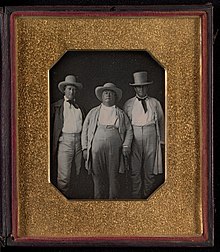
Although slavery had yet to become the most prominent political issue, states' rights would surface periodically in the early antebellum period, especially within the South. The election of Federalist member John Adams in the 1796 presidential election came in tandem with escalating tensions with France. In 1798, the XYZ Affair brought these tensions to the fore, and Adams became concerned about French power in America, fearing internal sabotage and malcontent that could be brought on by French agents. In response to these developments and to repeated attacks on Adams and the Federalists by Democratic-Republican publishers, Congress enacted the Alien and Sedition Acts. Enforcement of the acts resulted in the jailing of "seditious" Democratic-Republican editors throughout the North and South, and prompted the adoption of the Kentucky and Virginia Resolutions of 1798 (authored by Thomas Jefferson and James Madison), by the legislatures of those states.
Thirty years later, during the Nullification Crisis, the "Principles of '98" embodied in these resolutions were cited by leaders in South Carolina as a justification for state legislatures' asserting the power to nullify, or prevent the local application of, acts of the federal Congress that they deemed unconstitutional. The Nullification Crisis arose as a result of the Tariff of 1828, a set of high taxes on imports of manufactures, enacted by Congress as a protectionist measure to foster the development of domestic industry, primarily in the North. In 1832, the legislature of South Carolina nullified the entire "Tariff of Abominations", as the Tariff of 1828 was known in the South, prompting a stand-off between the state and federal government. On May 1, 1833, President Andrew Jackson wrote, "the tariff was only a pretext, and disunion and southern confederacy the real object. The next pretext will be the negro, or slavery question."[77][78] Although the crisis was resolved through a combination of the actions of the president, Congressional reduction of the tariff, and the Force Bill, it had lasting importance for the later development of secessionist thought.[79] An additional factor that led to Southern sectionalism was the proliferation of cultural and literary magazines such as the Southern Literary Messenger and DeBow's Review.[80]
Sectional parity and issue of slavery in new territories
[edit]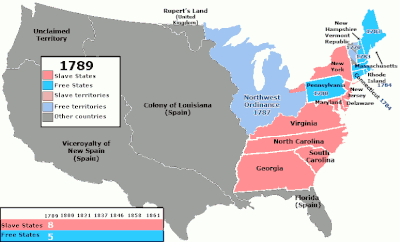
The primary issue feeding sectionalism was slavery, and especially the issue of whether to permit slavery in western territories seeking admission to the Union as states. In the early 19th century, as the cotton boom took hold, slavery became more economically viable on a large scale, and more Northerners began to perceive it as an economic threat, even if they remained indifferent to its moral dimension. While relatively few Northerners favored outright abolition, many more opposed the expansion of slavery to new territories, as in their view the availability of slaves lowered wages for free labor.
At the same time, Southerners increasingly perceived the economic and population growth of the North as threatening to their interests. For several decades after the Union was formed, as new states were admitted, North and South were able to finesse their sectional differences and maintain political balance by agreeing to admit "slave" and "free" states in equal numbers. By means of this compromise approach, the balance of power in the Senate could be extended indefinitely. The House of Representatives, however, was a different matter. As the North industrialized and its population grew, aided by a major influx of European immigrants, the Northern majority in the House of Representatives also grew, making Southern political leaders increasingly uncomfortable. Southerners became concerned that they would soon find themselves at the mercy of a federal government in which they no longer had sufficient representation to protect their interests. By the late 1840s, Senator Jefferson Davis from Mississippi stated that the new Northern majority in the Congress would make the government of the United States "an engine of Northern aggrandizement" and that Northern leaders had an agenda to "promote the industry of the United States at the expense of the people of the South."
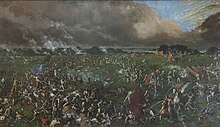
After the Mexican–American War, many Northerners became alarmed by new territory now being added on the Southern side of the free-slave boundary, the slavery-in-the-territories issue heated up dramatically. After a four-year sectional conflict, the Compromise of 1850 narrowly averted civil war with a complex deal in which California was admitted as a free state, including Southern California, thus preventing a separate slave territory there, while slavery was allowed in the New Mexico and Utah territories and a stronger Fugitive Slave Act of 1850 was passed, requiring all citizens to assist in recapturing runaway slaves wherever found. Four years later, the peace bought with successive compromises finally came to an end. In the Kansas–Nebraska Act, Congress left the issue of slavery to a vote in each territory, thereby provoking a breakdown of law and order as rival groups of pro- and anti-slavery immigrants competed to populate the newly settled region.
Election of 1860, secession, and Lincoln's response
[edit]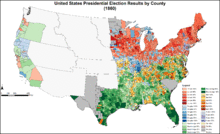
For many Southerners, the last straws were the raid on Harper's Ferry in 1859 by abolitionist John Brown, immediately followed by a Northern Republican victory in the presidential election of 1860. Notably, South Carolina had no popular vote. Republican Abraham Lincoln was elected president in a hotly contested four way race. In Southern States local leaders ensured that Lincoln was blocked from the ballot, instead most voters made a choice between hard line Breckingridge and Bell who advocated preservation of the union, slavery was the prevailing subject of the election. Beckingbridge argued that Southern independence was desirable to protect slavery if Lincoln was elected; Bell argued that the constitution protected slavery so that secession was unnecessary.[81]
Members of the South Carolina legislature had previously sworn to secede from the Union if Lincoln was elected, and the state declared its secession on December 20, 1860. South Carolina's declaration of secession mentioned slavery 17 times and justifying South Carolina's independence in lieu of looming property rights violations (the right to own slaves) by the national government. In January and February, six other cotton states of the Deep South followed suit: Mississippi, Florida, Alabama, Georgia, Louisiana, and Texas. The other eight slave states postponed a decision, but the seven formed a new government in Montgomery, Alabama, in February: the Confederate States of America. Throughout the South, Confederates seized federal arsenals and forts, without resistance, and forced the surrender of all U.S. forces in Texas. The sitting president, James Buchanan, believed he had no constitutional power to act, and in the four months between Lincoln's election and his inauguration, the South strengthened its military position.[82]
In Washington, proposals for compromise and reunion went nowhere, as the Confederates demanded complete, total, permanent independence. When Lincoln dispatched a supply ship to federal-held Fort Sumter, in South Carolina, the Confederate government ordered an attack on the fort, which surrendered on April 13. President Lincoln called upon the states to supply 75,000 troops to serve for ninety days to recover federal property, and, forced to choose sides, Virginia, Arkansas, Tennessee, and North Carolina promptly voted to secede. Kentucky declared its neutrality.[83]
Confederate States (1861–1865)
[edit]
The seceded states, joined as the Confederate States of America sought to consolidate control over border southern states including Kentucky and Missouri, The Confederate government also envisioned westward expansion through its Arizona territory- one goal being to extend the CSA to the Pacific Coast.[84] An invasion of Spanish Cuba was discussed and remained a possibility if Confederate independence had been achieved.[85] After secession, no compromise was possible, because the Confederacy insisted on its independence and the Lincoln Administration refused to meet with President Davis's commissioners. Lincoln ordered that a Navy fleet of warships and troop transports be sent to Charleston Harbor to reinforce and resupply Fort Sumter. Just before the fleet was about to enter the harbor, Confederates unleashed a massive bombardment and forced the Federal garrison holed up in the fort to surrender. The incident, prompted President Lincoln to proclaim that United States forces had been attacked and called for mobilizations to restore Government control in the seceded states. In response the Confederate military strategy was to hold its territory together, gain worldwide recognition, and inflict so much punishment on invaders that the Northerners would tire of an expensive war and negotiate a peace treaty that would recognize the independence of the CSA. Two Confederate counter-offensives into Maryland and southern Pennsylvania failed to influence Federal elections as hoped. The victory of Lincoln and his party in the 1864 elections made the Union's military victory only a matter of time.[86]
Both sides wanted the border southern states, with the Confederacy controlling half of Kentucky and the southern portion of Missouri early in the war, but the Union military forces took control of all of them in 1861–1862. Union victories in western Virginia allowed a Unionist government based in Wheeling to take control of western Virginia and, with Washington's approval, create the new state of West Virginia.[87] The Confederacy did recruit troops in the border states, but the enormous advantage of controlling them went to the Union.
| Union | CSA | |
|---|---|---|
| Total population | 22,000,000 (71%) | 9,000,000 (29%) |
| Free population | 22,000,000 | 5,500,000 |
| 1860 Border state slaves | 432,586 | NA |
| 1860 Southern slaves | NA | 3,500,000 |
| Soldiers | 2,200,000 (67%) | 1,064,000 (33%) |
| Railroad miles | 21,788 (71%) | 8,838 (29%) |
| Manufactured items | 90% | 10% |
| Firearm production | 97% | 3% |
| Bales of cotton in 1860 | Negligible | 4,500,000 |
| Bales of cotton in 1864 | Negligible | 300,000 |
| Pre-war U.S. exports | 30% | 70% |
The Union naval blockade, starting in May 1861, reduced exports by 95%; only small, fast blockade runners—mostly owned and operated by British interests—could get through. The South's vast cotton crops became nearly worthless.[89]
In 1861 the rebels assumed that "King Cotton" was so powerful that the threat of losing their supplies would induce Britain and France to enter the war as allies, and thereby frustrate Union efforts. Confederate leaders were ignorant of European conditions; Britain depended on the Union for its food supply, and would not benefit from an extremely expensive major war with the U.S. The Confederacy moved its capital from a defensible location in remote Montgomery, Alabama, to the more cosmopolitan city of Richmond, Virginia, only 100 miles (160 km) from Washington. Richmond had the heritage and facilities to match those of Washington, but its proximity to the Union forced the CSA to spend most of its war-making capability to defend Richmond.[citation needed]
Politics and Government
[edit]The strength of the Confederacy included an unusually strong officer corps—about a third of the officers of the U.S. Army had resigned and joined. But the political leadership was not very effective. A classic interpretation is that the Confederacy "died of states' rights", as governors of Texas, Georgia, and North Carolina refused Richmond's request for troops.[90]
The Confederate government was formed to explicitly protect the institution of slavery as stated by Vice President Alexander H. Stephens and thus enshrined slavery in its constitution.[91] The U.S. Constitution has a clause that states "No bill of attainder or ex post facto law shall be passed,"[92] the Confederate Constitution added onto this a phrase that explicitly protected slavery.[93][94]
Article I Section 9(4) No bill of attainder, ex post facto law, or law denying or impairing the right of property in negro slaves shall be passed.[93]
The Confederacy decided not to have political parties. There was a strong sense that parties were divisive and would weaken the war effort. Historians, however, agree that the lack of parties weakened the political system. Instead of having a viable alternative to the current system, as expressed by a rival party, the people could only grumble and complain and lose faith.[95]
Historians disparage the effectiveness of President Jefferson Davis, with a consensus holding that he was much less effective than Abraham Lincoln.[95]: 754 As a former Army officer, senator, and Secretary of War, he possessed the stature and experience to be president, but certain character defects undercut his performance. He played favorites and was imperious, frosty, and quarrelsome. By dispensing with parties, he lost the chance to build a grass roots network that would provide critically needed support in dark hours. Instead, he took the brunt of the blame for all difficulties and disasters. Davis was animated by a profound vision of a powerful, opulent new nation, the Confederate States of America, premised on the right of its white citizens to self-government. However, in dramatic contrast to Lincoln, he was never able to articulate that vision or provide a coherent strategy to fight the war. He neglected the civilian needs of the Confederacy while spending too much time meddling in military details. Davis's meddling in military strategy proved counterproductive. His explicit orders that Vicksburg be held no matter what sabotaged the only feasible defense and led directly to the fall of the city in 1863.[96][97]
Abolition of slavery
[edit]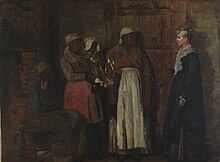
Across the South, widespread rumors alarmed the whites by predicting the slaves were planning some sort of insurrection. Patrols were stepped up. The slaves did become increasingly independent, and resistant to punishment, but historians agree there were no insurrections. In the invaded areas, insubordination was more the norm than was loyalty to the old master; Bell Wiley says, "It was not disloyalty, but the lure of freedom." Many slaves became spies for the North, and large numbers ran away to federal lines.[98]
By 1862, most Northern leaders realized that the mainstay of Southern secession, slavery, had to be attacked head-on. All the border states rejected President Lincoln's proposal for compensated emancipation. However, by 1865 all had begun the abolition of slavery, except Kentucky and Delaware. The Emancipation Proclamation was an executive order issued by Lincoln on January 1, 1863. In a single stroke it changed the legal status, as recognized by the U.S. government, of 3 million slaves in designated areas of the Confederacy from "slave" to "free". It had the practical effect that as soon as a slave escaped the control of the Confederate government, by running away or through advances of federal troops, the slave became legally and actually free. Plantation owners, realizing that emancipation would destroy their economic system, sometimes moved their slaves as far as possible out of reach of the Union Army. By June 1865, the Union Army controlled all of the Confederacy and liberated all of the designated slaves. The owners were never compensated. Nor were the slaves themselves.[99] Many of the freedmen remained on the same plantation, others crowded into refugee camps operated by the Freedmen's Bureau. The Bureau provided food, housing, clothing, medical care, church services, some schooling, legal support, and arranged for labor contracts.[100]
Historian Leon Litwack has noted, "Neither white nor black Southerners were unaffected by the physical and emotional demands of the war. Scarcities of food and clothing, for example, imposed hardships on both races." Conditions were worse for blacks.[101] Late in the war and soon after large numbers of blacks moved away from the plantation. The Freedmen's Bureau refugee camps saw infectious disease such as smallpox reach epidemic proportions. Jim Downs states:
- Disease and sickness had more devastating and fatal effects on emancipated slaves than on soldiers, since ex-slaves often lacked the basic necessities to survive. Emancipation liberated bonds people from slavery, but they often lacked clean clothing, adequate shelter, proper food, and access to medicine in their escape toward Union lines. Many free slaves died once they secured refuge behind union camps.[102]
Railroads
[edit]
The Union had a 3–1 superiority in railroad mileage and (even more important) an overwhelming advantage in engineers and mechanics in the rolling mills, machine shops, factories, roundhouses and repair yards that produced and maintained rails, bridging equipage, locomotives, rolling stock, signaling gear, and telegraph equipment. In peacetime the South imported all its railroad gear from the North; the Union blockade completely cut off such imports. The lines in the South were mostly designed for short hauls, as from cotton areas to river or ocean ports; they were not designed for trips of more than 100 miles or so, and such trips involved numerous changes of trains and layovers.[103] The South's 8,500 miles (13,700 km) of track comprised enough of a railroad system to handle essential military traffic along some internal lines, assuming it could be defended and maintained. As the system deteriorated because of worn out equipment, accidents and sabotage, the South was unable to construct or even repair new locomotives, cars, signals or track. Little new equipment ever arrived, although rails in remote areas such as Florida were removed and put to more efficient use in the war zones. Realizing their enemy's dilemma, Union cavalry raids routinely destroyed locomotives, cars, rails, roundhouses, trestles, bridges, and telegraph wires. By the end of the war, the southern railroad system was totally ruined. Meanwhile, the Union army rebuilt rail lines to supply its forces. A Union railroad through hostile territory, as from Nashville to Atlanta in 1864, was an essential but fragile lifeline—it took a whole army to guard it, because each foot of track had to be secure. Large numbers of Union soldiers throughout the war were assigned to guard duty and, while always ready for action, seldom saw any fighting.[104]
Southern Unionists
[edit]Among Southern White populations and lawmakers there was never universal support for separation from the National Government, particularly in the upper south. Virginia's state legislature at first voted by 2/3 to remain in the United States, after the fall of Fort Sumpter 36% of the delegates again voted against secession. Meanwhile North Carolina voted by popular referendum to remain in the United States; when North Carolina later seceded anyway the governor would not permit a second referendum to be held. Tennessee had strong unionist sentiment in its eastern Appalachian counties.[105][106] Further west Kentucky's Pro Confederate Governor declared neutrality because he believed the majority of the white population would refuse secession.[107]
Southerners who were against the Confederate cause during the Civil War were known as Southern Unionists. They were also known as Union Loyalists or Lincoln's Loyalists. Within the eleven Confederate states, states such as Tennessee (especially East Tennessee), Virginia (which included West Virginia at the time), and North Carolina were home to the largest populations of Unionists. Many areas of Southern Appalachia harbored pro-Union sentiment as well. As many as 100,000 men living in states under Confederate control would serve in the Union Army or pro-Union guerrilla groups. Every State had an organized Unionist army with the exception of South Carolina. Although Southern Unionists came from all classes, most differed socially, culturally, and economically from the region's dominant pre-war planter class.[108] As a reward for loyalty to the capital and with the protection of Union soldiers, West Virginia was granted its independence from the rest of Virginia by congress in 1863. Cities and areas farther away from Eastern Virginia were more supportive of statehood.[109] In Mississippi a county broke away from the Confederacy and freed the slaves, becoming the Free State of Jones.[110]
In Texas, local officials harassed and murdered Unionists and Germans during the Civil War. In Cooke County, Texas, 150 suspected Unionists were arrested; 25 were lynched without trial and 40 more were hanged after a summary trial. Draft resistance was widespread especially among Texans of German or Mexican descent; many of the latter leaving to Mexico. Confederate officials would attempt to hunt down and kill potential draftees who had gone into hiding.[111]
A study of Southern Unionists in Alabama who continued to support the Union during the war found that they were typically "old fashioned" or "Jackson" conservative Democrats, or former Whigs, who viewed the federal government as worthy of defending because it had provided economic and political security. A section of slaveholding unionists believed preserving the union was more important than protecting slavery. The Southern ideals of honor, family, and duty were as important to Unionists as to their pro-secession neighbors. They believed, however, that rebelling against the United States, which many of their ancestors had fought for in 1776 and 1812, was the unmanly and dishonorable act.[112]
Indian Territory
[edit]
Confederate supporters in the trans-Mississippi west also claimed portions of the Indian Territory after the United States evacuated the federal forts and installations. These were the same Native American Nations that had been subject to removal thirty years before. Over half of the American Indian troops participating in the Civil War from the Indian Territory supported the Confederacy; troops and one general were enlisted from each tribe. On July 12, 1861, the Confederate government signed a treaty with both the Choctaw and Chickasaw Indian nations. After several battles, Union armies took control of the territory.[113]
The Indian Territory never formally joined the Confederacy, but it did receive representation in the Confederate Congress. Many Indians from the Territory were integrated into regular Confederate Army units. After 1863, the tribal governments sent representatives to the Confederate Congress: Elias Cornelius Boudinot representing the Cherokee and Samuel Benton Callahan representing the Seminole and Creek. The Cherokee Nation aligned with the Confederacy. They practiced and supported slavery, opposed abolition, and feared their lands would be seized by the Union. After the war, the Indian territory was disestablished, their black slaves were freed, and the tribes lost some of their lands.[114]
Sherman's March
[edit]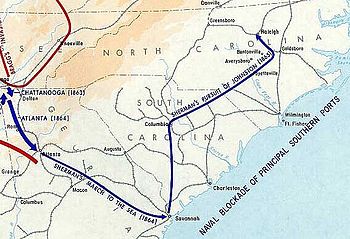
By 1864, the top Union generals Ulysses S. Grant and William T. Sherman realized the weakest point of the Confederate armies was the decrepitude of the southern infrastructure, so they escalated efforts to wear it down. Cavalry raids were the favorite device, with instructions to ruin railroads and bridges. Sherman's insight was deeper. He focused on the trust the rebels had in their Confederacy as a living nation, and he set out to destroy that trust; he predicted his raid would "demonstrate the vulnerability of the South, and make its inhabitants feel that war and individual ruin are synonymous terms."[115] Sherman's "March to the Sea" from Atlanta to Savannah in the fall of 1864 burned and ruined every part of the industrial, commercial, transportation and agricultural infrastructure it touched, but the actual damage was confined to a swath of territory totaling about 15% of Georgia. Sherman struck at Georgia in October, just after the harvest, when the food supplies for the next year had been gathered and were exposed to destruction. In early 1865, Sherman's army moved north through the Carolinas in a campaign even more devastating than the march through Georgia. More telling than the twisted rails, smoldering main streets, dead cattle, burning barns and ransacked houses was the bitter realization among civilians and soldiers throughout the remaining Confederacy that if they persisted, sooner or later their homes and communities would receive the same treatment.[116] According to a 2022 American Economic Journal study which sought to measure the medium- and long-term economic impact of Sherman's March, "the capital destruction induced by the March led to a large contraction in agricultural investment, farming asset prices, and manufacturing activity. Elements of the decline in agriculture persisted through 1920".[117]
The March attracted a huge number of refugees, to whom Sherman assigned land with his Special Field Orders No. 15. These orders have been depicted in popular culture as the origin of the "40 acres and a mule" promise.[118] Slaves' opinions varied concerning the actions of Sherman and his army.[119] Some who welcomed him as a liberator chose to follow his armies. Jacqueline Campbell has written, on the other hand, that some slaves looked upon the Union army's ransacking and invasive actions with disdain. They often felt betrayed, as they "suffered along with their owners, complicating their decision of whether to flee with or from Union troops", although that is now seen as a post synopsis of Confederate nationalism.[120] A Confederate officer estimated that 10,000 liberated slaves followed Sherman's army, and hundreds died of "hunger, disease, or exposure" along the way.[121]
Material ruin and human losses
[edit]The Conclusion of the American Civil War and Reconstruction played out against a backdrop of a once prosperous economy that lay in ruins. According to Hesseltine (1936),
The soldiers who returned from the war found widespread desolation at their homes. In the Shenandoah Valley, blackened chimneys stood sentinel over cold ash heaps which once were houses. Throughout the South, fences were down, weeds had overrun the fields, windows were broken, live stock had disappeared. The assessed valuation of property declined from 30 to 60 percent in the decade after 1860. . . . In Mobile, business was stagnant; Chattanooga and Nashville were ruined; and Atlanta's industrial sections were in ashes.[122]
-
Atlanta first union station in ruins 1864
-
Bloody Lane Battle of Antietam, 1862
-
Ruins of Richmond after the Siege of Petersburg April 1865
Estimate of Confederate losses were 94,000 killed in battle, 164,000 who died of disease, and 26,000 who died in Union prisons.[123] Estimate of Union losses were 110,000 killed in battle, 225,000 who died of disease, and 30,000 who died in Confederate prisons.[124] Northern military deaths were greater than Southern military deaths in absolute numbers, but were two-thirds smaller in terms of proportion of population affected.
The number of civilian deaths during the war is unknown, but was highest among refugees and former slaves.[102][125] Most of the war was fought in Virginia and Tennessee, but every Confederate state was affected, as well as the border states of Maryland, West Virginia, Kentucky, Missouri, and Indian Territory; Pennsylvania was the only northerner state to be the scene of major action, during the Gettysburg Campaign. In the Confederacy there was little military action in Texas and Florida. Of 645 counties in nine Confederate states (excluding Texas and Florida), there was Union military action in 56% of them, containing 63% of the whites and 64% of the slaves in 1860; however, by the time the action took place some people had fled to safer areas, so the exact population exposed to war is unknown.[126]
The Confederacy in 1861 had 297 towns and cities with 835,000 people; of these 162 with 681,000 people were at one point occupied by Union forces. Ten were destroyed or severely damaged by war action, including Atlanta (with an 1860 population of 9,600), Columbia, and Richmond (with prewar populations of 8,100 and 37,900, respectively), plus Charleston, much of which was destroyed in an accidental fire in 1861. These eleven contained 115,900 people in the 1860 census, or 14% of the urban South. Historians have not estimated their population when they were invaded. The number of people who lived in the destroyed towns represented just over 1% of the Confederacy's population. In addition, 45 courthouses were burned (out of 830). The South's agriculture was not highly mechanized. The value of farm implements and machinery in the 1860 Census was $81 million; by 1870, there was 40% less, or $48 million worth. Many old tools had broken through heavy use and could not be replaced; even repairs were difficult.[126]
The economic calamity suffered by the South during had widespread implications. Except for land, most assets and investments had vanished with slavery, but debts were left behind. Worst of all were the human deaths and amputations. Most farms were intact but most had lost their horses, mules and cattle; fences and barns were in disrepair. Prices for cotton had plunged. The rebuilding would take years and require outside investment because the devastation was so thorough. One historian has summarized the collapse of the transportation infrastructure needed for economic recovery.[127]
One of the greatest calamities which confronted Southerners was the havoc wrought on the transportation system. Roads were impassable or nonexistent, and bridges were destroyed or washed away. The important river traffic was at a standstill: levees were broken, channels were blocked, the few steamboats which had not been captured or destroyed were in a state of disrepair, wharves had decayed or were missing, and trained personnel were dead or dispersed. Horses, mules, oxen, carriages, wagons, and carts had nearly all fallen prey at one time or another to the contending armies. The railroads were paralyzed, with most of the companies bankrupt. These lines had been the special target of the enemy. On one stretch of 114 miles in Alabama, every bridge and trestle was destroyed, cross-ties rotten, buildings burned, water-tanks gone, ditches filled up, and tracks grown up in weeds and bushes. ... Communication centers like Columbia and Atlanta were in ruins; shops and foundries were wrecked or in disrepair. Even those areas bypassed by battle had been pirated for equipment needed on the battlefront, and the wear and tear of wartime usage without adequate repairs or replacements reduced all to a state of disintegration.
Railroad mileage was of course located mostly in rural areas. The war followed the rails, and over two-thirds of the South's rails, bridges, rail yards, repair shops and rolling stock were in areas reached by Union armies, which systematically destroyed what it could. The South had 9,400 miles (15,100 km) of track, and 6,500 miles (10,500 km) were in areas reached by the Union armies. About 4,400 miles (7,100 km) were in areas where Sherman and other Union generals adopted a policy of systematic destruction of the rail system. Even in untouched areas, the lack of maintenance and repair, the absence of new equipment, the heavy over-use, and the deliberate movement of equipment by the Confederates from remote areas to the war zone guaranteed the system would be virtually ruined at war's end.[126] The war was effectively over with the surrender at Appomattox Court House in April 1865. There were no trials for insurgency or treason and only one war crimes trial.
Reconstruction (1865–1877)
[edit]The Reconstruction era began following the end of the Civil War in 1865 and lasted until 1877. During this time, the Union Army took control of former Confederate states, except for Tennessee; the start and ending times of Union Army occupation varied by state. Slavery ended and the large slave-based plantations were mostly subdivided into tenant or sharecropper farms of 20–40 acres (8.1–16.2 ha). Many white farmers (and some blacks) owned their land. However sharecropping, along with tenant farming, became a dominant form in the cotton South from the 1870s to the 1950s, among both blacks and whites. By the 1960s both had largely disappeared.
Sharecropping was a way for very poor farmers to earn a living from land owned by someone else. The landowner provided land, housing, tools and seed, and perhaps a mule, and a local merchant provided food and supplies on credit. At harvest time the sharecropper received a share of the crop (from one-third to one-half, with the landowner taking the rest). The cropper used his share to pay off his debt to the merchant. The system started with blacks when large plantations were subdivided. By the 1880s white farmers also became sharecroppers.
The system was distinct from that of the tenant farmer, who rented the land, provided his own tools and mule, and received half the crop. Landowners provided more supervision to sharecroppers, and less or none to tenant farmers.[128][129]
Political Reconstruction
[edit]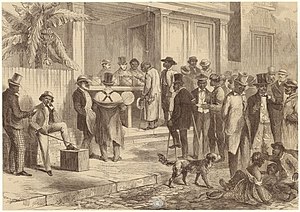
Reconstruction was the process by which the states returned to full status. It took place in four stages, which varied by state. Tennessee and the border states were not affected. First came the governments appointed by President Andrew Johnson that lasted 1865–1866. The Freedmen's Bureau was active, helping refugees, setting up employment contracts for Freedmen, and setting up courts and schools for the freedmen. Second came rule by the U.S. Army, which held elections that included all freedmen and also excluded over 10,000 former Confederate leaders on account of their prior war on the United States government. Third was "Radical Reconstruction" or "Black Reconstruction" in which a Republican coalition governed the state, comprising a coalition of freedmen, scalawags (native Southern whites) and carpetbaggers (migrants from the North). Violent terrorism by the Ku Klux Klan and related groups was suppressed by President Ulysses S. Grant and the vigorous use of federal courts and soldiers. The Reconstruction governments spent large sums on railroad subsidies and schools, but quadrupled taxes and set off a tax revolt. Stage four was reached by 1876 by a coalition of white supremacists and former confederates, called "Redeemers", had won political control of all the states except South Carolina, Florida and Louisiana. The disputed presidential election of 1876 hinged on those three violently contested states. The outcome was the Compromise of 1877, whereby the Republican Rutherford Hayes became president and all federal troops were withdrawn from the South, leading to the immediate collapse of the last Republican state governments in the 19th century.
Railroads
[edit]The building of a new, modern rail system was widely seen as essential to the economic recovery of the South, and modernizers invested in a "Gospel of Prosperity". Northern money financed the rebuilding and dramatic expansion of railroads throughout the South; they were modernized in terms of rail gauge, equipment and standards of service. The Panic of 1873 ended the expansion everywhere in the United States, leaving many Southern lines bankrupt or barely able to pay the interest on their bonds.
The Southern network still expanded from 11,000 miles (18,000 km) in 1870 to 29,000 miles (47,000 km) in 1890. Railroads helped create a mechanically skilled group of craftsmen and broke the isolation of much of the region. Passengers were few, however, and apart from hauling the cotton crop when it was harvested, there was little freight traffic.[130][131] The lines were owned and directed overwhelmingly by Northerners, who often had to pay heavy bribes to corrupt politicians for needed legislation.[132]
Backlash to Reconstruction
[edit]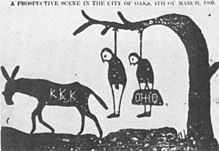
Reconstruction offended former confederates who found themselves without the ability to vote due to the Ironclad Oath[133] Anti Confederate disenfranchisement sometimes excluded 10–20% of white voters in certain states and smaller groups in others.[134] Most Ex Confederate restrictions were lifted by 1870 though all were completely repealed in 1884.
Reconstruction was also a time when many African Americans and some poor whites began to secure these same rights for the first time. With the passage of the 13th Amendment to the Constitution (which outlawed slavery), the 14th Amendment (which granted full U.S. citizenship to African Americans) and the 15th Amendment (which extended the right to vote to black males), African Americans in the South began to enjoy more rights than they had ever had in the past.[135]
A reaction to the defeat and changes in society began immediately, with terrorist groups such as the Ku Klux Klan arising in 1866 as the first line of insurgents. They attacked and killed both freedmen and their white allies. By the 1870s, more organized paramilitary groups, such as the White League and Red Shirts, took part in turning Republicans out of office and barring or intimidating black people from voting. A standard example of white supremacist violence in the period is the Camilla massacre where twelve African Americans were murdered by a mob for attempting to attend a Republican political rally. The brutality caused Congress to temporarily revoke Georgia's statehood.[136]
Mississippi Representative Wiley P. Harris, a Democrat, explained the white supremacist perspective in 1875:
If any two hundred Southern men backed by a Federal administration should go to Indianapolis, turn out the Indiana people, take possession of all the seats of power, honor, and profit, denounce the people at large as assassins and barbarians, introduce corruption in all the branches of the public administration, make government a curse instead of a blessing, league with the most ignorant class of society to make war on the enlightened, intelligent, and virtuous, what kind of social relations would such a state of things beget.[137]
The South: rural life, Jim Crow and reindustrialization 1877–1933
[edit]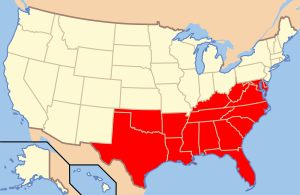
Agriculture's share of the labor force by region, 1890:
| Northeast | 15% |
| Middle Atlantic | 17% |
| Midwest | 43% |
| South Atlantic | 63% |
| South Central | 67% |
| West | 29% |
| Source[139] |
Economy of the Jim Crow South
[edit]
The South remained heavily rural until World War II. In the decades before the 1940s, there were only a few scattered large cities in the region, with small courthouse towns serving the mostly rural population. Local politics revolved around the politicians and lawyers based at the courthouse. Mill towns, primarily focused on textile production or tobacco product manufacture, began opening in the Piedmont region, especially in the Carolinas. Racial segregation and outward signs of inequality were commonplace in many rural areas and rarely challenged. Blacks who violated the color line were liable to expulsion or lynching.[140] Cotton became even more important than before, even though prices were much lower. The number of small farms in rural areas overtime proliferated, and became smaller and smaller as the population grew.
Many white farmers, and some black farmers, were tenant farmers who owned their work animals and tools, and rented their land. Others were day laborers or impoverished sharecroppers, who worked under the supervision of the landowner. Sharecropping was a way for landless farmers (both black and white) to earn a living. The landowner provided land, housing, tools and seed, and perhaps a mule, and a local merchant loaned money for food and supplies. At harvest time, the sharecropper received a share of the crop (from one-third to one-half), which paid off his debt to the merchant. By the late 1860s, white farmers had also become sharecroppers. The cropper system was a step below that of the tenant farmer, who rented the land, provided his own tools and mule, and received half the crop. Landowners provided more supervision to sharecroppers, and less or none to tenant farmers.[141]

There was little cash in circulation, since most farmers operated on credit accounts from local merchants, and paid off their debts at cotton harvest time in the fall. Although there were small country churches everywhere, there were only a few dilapidated schools in rural areas. High schools were available in the cities, but were hard to find in most rural areas. All the Southern high schools combined graduated 66,000 students in 1928. The school terms were shorter in the South, and total spending per student was much lower. Nationwide, the students in elementary and secondary schools attended 140 days of school in 1928, compared to 123 days for white children in the South and 95 for blacks. The national average in 1928 for school expenditures was $70,700 for every 1,000 children aged 5–17. Only Florida reached that level, and seven of the thirteen Southern states spent under $31,000 per 1,000 children.[142][143] Conditions were marginally better in newer growing areas, such as in Texas and central Florida, with the deepest poverty in South Carolina, Louisiana, Mississippi, and Arkansas. Hookworm and other diseases sapped the vitality of many Southerners in rural areas.[144][145][146]
Longstanding history was written by C. Vann Woodward, The Origins of the New South: 1877–1913, which was published in 1951 by Louisiana State University Press. Sheldon Hackney explains:
Of one thing we may be certain at the outset. The durability of Origins of the New South is not a result of its ennobling and uplifting message. It is the story of the decay and decline of the aristocracy, the suffering and betrayal of the poor whites, and the rise and transformation of a middle class. It is not a happy story. The Redeemers are revealed to be as venal as the carpetbaggers. The declining aristocracy are ineffectual and money hungry, and in the last analysis they subordinated the values of their political and social heritage in order to maintain control over the black population. The poor whites suffered from strange malignancies of racism and conspiracy-mindedness, and the rising middle class was timid and self-interested even in its reform movement. The most sympathetic characters in the whole sordid affair are simply those who are too powerless to be blamed for their actions.[147]
Meanwhile, the first major oil well in the South was drilled at Spindletop near Beaumont, Texas, on the morning of January 10, 1901. Other oil fields were later discovered nearby in Arkansas, Oklahoma, and under the Gulf of Mexico. The resulting "Oil Boom" permanently transformed the economy of the West South Central states and produced the richest economic expansion after the Civil War.[148][149] Certain locations of the South also took part of major inventions of the Gilded Age, including the Wright Flyer in the Outer Banks of North Carolina.
The Jim Crow Era: segregation, disenfranchisement and oppression
[edit]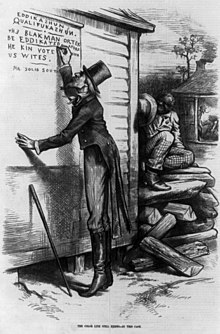
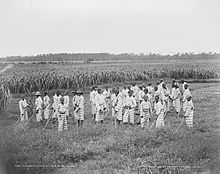
After the Redeemers took control in the mid-1870s, Jim Crow laws were created to legally enforce racial segregation in public facilities and services. The phrase "separate but equal", upheld in the 1896 Supreme Court case Plessy v. Ferguson, came to represent the notion that whites and blacks should have access to physically separate but ostensibly equal facilities. It would not be until 1954 that Plessy was overturned in Brown v. Board of Education, and only in the late 1960s was segregation fully repealed by legislation passed following the efforts of the civil rights movement.
The most extreme white leader was Senator Ben Tillman of South Carolina, who proudly proclaimed in 1900, "We have done our level best [to prevent blacks from voting] ... we have scratched our heads to find out how we could eliminate the last one of them. We stuffed ballot boxes. We shot them. We are not ashamed of it."[150] With no voting rights and no voice in government, blacks in the South were subjected to a system of segregation and discrimination. Blacks and whites attended separate schools. Blacks could not serve on juries, which meant that they had little if any legal recourse. In Black Boy, an autobiographical account of life during this time, Richard Wright writes about being struck with a bottle and knocked from a moving truck for failing to call a white man "sir".[151] Between 1889 and 1922, the NAACP calculates that lynchings reached their worst level in history, with almost 3,500 people, three-fourths of them black men, murdered.[152]
From 1890 to 1908, ten of the eleven former Confederate states, along with Oklahoma upon statehood, passed disenfranchising constitutions or amendments that introduced voter registration barriers – such as poll taxes, residency requirements and literacy tests – that were hard for minorities to meet. Most African Americans, most Mexican Americans, and tens of thousands of poor whites were disenfranchised, losing the vote for decades. In some states, grandfather clauses temporarily exempted white illiterates from literacy tests. The numbers of voters dropped drastically throughout the former Confederacy as a result. This can be seen via the feature "Turnout in Presidential and Midterm Elections" at the University of Texas' Politics: Barriers to Voting. Alabama, which had established universal white suffrage in 1819 when it became a state, also substantially reduced voting by poor whites.[153][154] Democrat-controlled legislatures passed Jim Crow laws to segregate public facilities and services, including transportation.
While African Americans, poor whites and civil rights groups started litigation against such provisions in the early 20th century, for decades Supreme Court decisions overturning such provisions were rapidly followed by new state laws with new devices to restrict voting. Most blacks in the former Confederacy and Oklahoma could not vote until 1965, after passage of the Voting Rights Act and Federal enforcement to ensure people could register. Despite increases in the eligible voting population with the inclusion of women, blacks, and those eighteen and over throughout this period, turnout in ex-Confederate states remained below the national average throughout the 20th century.[155] Not until the late 1960s did all American citizens regain protected civil rights by passage of legislation following the leadership of the American Civil Rights Movement.

Historian William Chafe has explored the defensive techniques developed inside the African American community to avoid the worst features of Jim Crow as expressed in the legal system, unbalanced economic power, and intimidation and psychological pressure. Chafe says "protective socialization by blacks themselves" was created inside the community to accommodate white-imposed sanctions while subtly encouraging challenges to those sanctions. Known as "walking the tightrope," such efforts at bringing about change were only slightly effective before the 1920s, but did build the foundation that younger African Americans deployed in their aggressive, large-scale activism during the civil rights movement in the 1950s and 1960s.[156]
In the early 20th century, invasion of the boll weevil devastated cotton crops in the South, producing an additional catalyst to African Americans' decisions to leave the South. From 1910 to 1970, more than 6.5 million African Americans left the South in the Great Migration to Northern and Western cities, defecting from persistent lynching, violence, segregation, poor education, and inability to vote. Black migration transformed many Northern and Western cities, creating new cultures and music. Many African Americans, like other groups, became industrial workers; others started their own businesses within the communities. Southern whites also migrated to industrial cities like Chicago, Detroit, Oakland, and Los Angeles, where they took jobs in the booming new auto and defense industry.
Depression and the home front of the south 1933–1945
[edit]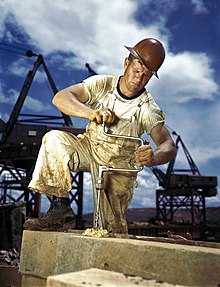
Later, the Southern economy was dealt additional blows by the Great Depression and the Dust Bowl. After the Wall Street Crash of 1929, the economy suffered significant reversals and millions were left unemployed. Beginning in 1934 and lasting until 1939, an ecological disaster of severe wind and drought caused an exodus from Texas and Arkansas, the Oklahoma Panhandle region, and the surrounding plains, in which over 500,000 Americans were homeless, hungry and jobless.[157] Thousands would leave the region to seek economic opportunities along the West Coast. While Franklin Roosevelt's progressive coalition and even Franklin's spouse Eleanor Roosevelt desired reforms, the Roosevelt administration did not interfere with Jim Crow and other racist policies as part of a compromise with the segregationist wing of the Southern Democratic Party. Without congressional votes from segregationist democrats New Deal legislation would have likely been blocked by congress.
President Franklin D. Roosevelt noted the South as the "number one priority" in terms of need of assistance during the Great Depression. His administration created programs such as the Tennessee Valley Authority in 1933 to provide rural electrification and stimulate development. Locked into low-productivity agriculture, the region's growth was slowed by limited industrial development, low levels of entrepreneurship, and the lack of capital investment.
World War II marked a time of dramatic change within the South from an economic standpoint, as new industries and military bases were developed by the federal government, providing much needed capital and infrastructure in many regions. People from all parts of the US came to the South for military training and work in the region's many bases and new industries. During and after the war millions of hard-scrabble farmers, both white and black, left agriculture for other occupations and urban jobs.[158][159][160] The United States began mobilizing for war in a major way in the spring of 1940. The warm weather of the South proved ideal for building 60% of the Army's new training camps and nearly half the new airfields. In all, 40% of spending on new military installations went to the South. For example, in 1940 the small town of 1500 people in Starke, Florida, became the base of Camp Blanding. By March 1941, 20,000 men were constructing a permanent camp for 60,000 soldiers. Money flowed freely for the war effort, as over $4 billion went into military facilities in the South, and another $5 billion into defense plants. Major shipyards were built in Virginia, and Charleston, SC, and along the Gulf Coast.

Huge warplane plants were opened in Dallas-Fort Worth and Georgia. The most secret and expensive operation was at Oak Ridge, Tennessee, where unlimited amounts of locally generated electricity were used to prepare uranium for the atom bomb.[161] The number of production workers doubled during the war. Most training centers, factories and shipyards were closed in 1945, but not all, and the families that left hardscrabble farms remained to find jobs in the growing urban South. The region had finally reached the take off stage into industrial and commercial growth, although its income and wage levels lagged well behind the national average. Nevertheless, as George B. Tindall notes, the transformation was, "The demonstration of industrial potential, new habits of mind, and a recognition that industrialization demanded community services."[162][163]
Per capita income jumped 140% from 1940 to 1945, compared to 100% elsewhere in the United States. Southern income rose from 59% to 65%. Dewey Grantham says the war, "brought an abrupt departure from the South's economic backwardness, poverty, and distinctive rural life, as the region moved perceptively closer to the mainstream of national economic and social life."[164]
The Remaking of The South 1945–1975
[edit]Race: from Jim Crow to the Civil Rights Movement
[edit]

African Americans responded to persistent oppression in the south with two major reactions: the Great Migration and the civil rights movement.
The Great Migration began during World War I, hitting its high point during World War II. During this migration, black people left the racism and lack of opportunities in the South and settled in northern cities like Chicago, where they found work in factories and other sectors of the economy.[165] This migration produced a new sense of independence in the black community and contributed to the vibrant black urban culture seen in the emergence of jazz and the blues from New Orleans and its spread north to Memphis and Chicago.[166]
The migration also empowered the growing civil rights movement.[167] While the movement existed in all parts of the United States to combat Jim Crow law policies, its focus was against the Jim Crow laws taking place in the South. Most of the major events in the movement occurred in the South, including the Montgomery bus boycott, the Mississippi Freedom Summer, the Selma to Montgomery marches, and the assassination of Martin Luther King Jr. In addition, some of the most important writings to come out of the movement were written in the South, such as King's "Letter from Birmingham Jail".
Most of the major events in the movement occurred in the South, including the Montgomery bus boycott, the Mississippi Freedom Summer, the March on Selma, Alabama, and the assassination of Martin Luther King Jr. In addition, some of the most important writings to come out of the movement were written in the South, such as King's "Letter from Birmingham Jail". Most of the civil rights landmarks can be found around the South. The Birmingham Civil Rights National Monument in Birmingham includes the Birmingham Civil Rights Institute which details Birmingham's role as the center of the Civil Rights Movement. The 16th Street Baptist Church served as a rallying point for coordinating and carrying out the Birmingham campaign as well as the adjacent Kelly Ingram Park that served as ground zero for the infamous children's protest that eventually led to the passage of the Civil Rights Act of 1964 has been rededicated as a place of "Revolution and Reconciliation" and is now the setting of moving sculptures related to the battle for Civil Rights in the city, both are center pieces of the Birmingham Civil Rights District. The Martin Luther King Jr. National Historical Park in Atlanta includes a museum that chronicles the American Civil Rights Movement as well as Martin Luther King Jr.'s boyhood home on Auburn Avenue. Additionally, Ebenezer Baptist Church is located in the Sweet Auburn district as is the King Center, location of Martin Luther and Coretta Scott King's gravesites.
Confrontations continued to escalate. In summer 1963, there were 800 demonstrations in 200 southern cities and towns, with over 100,000 participants, and 15,000 arrests. In Alabama in June 1963, Governor George Wallace escalated the crisis by defying court orders to admit the first two black students to the University of Alabama.[168] Kennedy responded by sending Congress a comprehensive civil rights bill, and ordered Attorney General Robert Kennedy to file federal lawsuits against segregated schools, and to deny funds for discriminatory programs. Doctor King launched a massive march on Washington in August 1963, bringing out 200,000 demonstrators in front of the Lincoln Memorial, the largest political assembly in the nation's history. The Kennedy administration now gave full-fledged support to the civil rights movement, but powerful southern congressmen blocked any legislation.[169] After Kennedy was assassinated President Lyndon Johnson called for immediate passage of Kennedy civil rights legislation as a memorial to the martyred president. Johnson formed a coalition with Northern Republicans that led to passage in the House, and with the help of Republican Senate leader Everett Dirksen with passage in the Senate early in 1964. For the first time in history, the southern filibuster was broken and the Senate finally passed its version on June 19 by vote of 73 to 27.[170] The Civil Rights Act of 1964 was the most powerful affirmation of equal rights ever made by Congress. It guaranteed access to public accommodations such as restaurants and places of amusement, authorized the Justice Department to bring suits to desegregate facilities in schools, gave new powers to the Civil Rights Commission; and allowed federal funds to be cut off in cases of discrimination. Furthermore, racial, religious and gender discrimination was outlawed for businesses with 25 or more employees, as well as apartment houses. The South resisted until the last moment, but as soon as the new law was signed by President Johnson on July 2, 1964, it was widely accepted across the nation. There was only a scattering of diehard opposition, typified by restaurant owner Lester Maddox in Georgia, who became governor, but the great majority of restaurants and hotels in Georgia followed the new law as the business community realized that peaceful integration was the only way forward.[171][172][173][174]
-
Rosa Parks being fingerprinted by Deputy Sheriff D.H. Lackey after being arrested on February 22, 1956, during the Montgomery bus boycott
-
Freedom Riders that had been arrested and taken to a police department in Jackson, Mississippi.
-
Roy Wilkins in press conference with Autherine Lucy and Thurgood Marshall, director and special counsel for NAACP Legal Defense and Education Fund]. Autherine Lucy was the first African-American student to attend the University of Alabama who later expelled her.
In January 1965, Martin Luther King Jr., James Bevel,[175][176] and other civil rights leaders organized several peaceful demonstrations in Selma, which were violently attacked by police and white counter-protesters. Throughout January and February, these protests received national media coverage and drew attention to the issue of voting rights. King and other demonstrators were arrested during a march on February 1 for violating an anti-parade ordinance; this inspired similar marches in the following days, causing hundreds more to be arrested.[177]: 259–261 On February 4, civil rights leader Malcolm X gave a militant speech in Selma in which he said that many African Americans did not support King's nonviolent approach;[177]: 262 he later privately said that he wanted to frighten whites into supporting King. The next day, King was released and a letter he wrote addressing voting rights, "Letter From A Selma Jail", appeared in The New York Times.
With increasing national attention focused on Selma and voting rights, President Johnson reversed his decision to delay voting rights legislation. On February 6, he announced he would send a proposal to Congress. Johnson did not reveal the proposal's content or disclose when it would come before Congress.
On February 18 in Marion, Alabama, state troopers violently broke up a nighttime voting-rights march during which officer James Bonard Fowler shot and killed young African-American protester Jimmie Lee Jackson, who was unarmed and protecting his mother.[177]: 265 [178] Spurred by this event, and at the initiation of Bevel,[177]: 267 [175][176][179]: 81–86 on March 7 SCLC and SNCC began the first of the Selma to Montgomery marches, in which Selma residents intended to march to Alabama's capital, Montgomery, to highlight voting rights issues and present Governor George Wallace with their grievances. On the first march, demonstrators were stopped by state and county police on horseback at the Edmund Pettus Bridge near Selma. The police shot tear gas into the crowd and trampled protesters. Televised footage of the scene, which became known as "Bloody Sunday", generated outrage across the country.[180]: 515
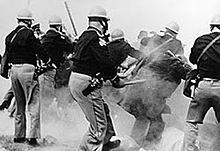

A second march was held on March 9, which became known as "Turnaround Tuesday". That evening, three white Unitarian ministers who participated in the march were attacked on the street and beaten with clubs by four Ku Klux Klan members.[181] The worst injured was Reverend James Reeb from Boston, who died on Thursday, March 11.[182]
In the wake of the events in Selma, President Johnson, addressing a televised joint session of Congress on March 15, called on legislators to enact expansive voting rights legislation. In his speech, he used the words "we shall overcome", adopting the rallying cry of the civil rights movement.[177]: 278 [183] The Voting Rights Act of 1965 was introduced in Congress two days later while civil rights leaders, now under the protection of federal troops, led a march of 25,000 people from Selma to Montgomery.[180]: 516 [177]: 279, 282
After the passage of the Voting Rights Act, President Lyndon Johnson with the support and urging of Civil Rights leaders launched the War on poverty. This ambitious set of programs sought to eradicate poverty across the United States, when the program began 45.9 percentage of America's impoverished lived in the South though it had only 31% of the population. Fifty years later, poverty did not disappear but it was also less concentrated in the Southeast Region and was more balanced across the country as a whole.[184]
Since the enactment of the Civil Rights Act of 1964 and Voting Rights Act of 1965, black people have gone on to hold many offices within the Southern states. Black people have been elected or appointed as mayors or police chiefs in the cities of Atlanta, Baltimore, Birmingham, Charlotte, Columbia, Dover, Houston, Jackson, Jacksonville, Memphis, Montgomery, Nashville, New Orleans, Raleigh, Richmond, and Washington. They have also gone on to serve in both the U.S. Congress and state legislatures of Southern states.[185]
Since 1970, the proportion of the African American population living in the South stabilized and began slightly increasing.[186]
Collapse of the Black Belt socioeconomic plantation system
[edit]Economic historians of the South generally emphasize the continuity of the system of white supremacy and cotton plantations in the Black Belt from the late colonial era into the mid-20th century, when it collapsed.[citation needed] Harold D, Woodman summarizes the explanation that external forces caused the disintegration from the 1920s to the 1970s:
- When a significant change finally occurred, its impetus came from outside the South. Depression-bred New Deal reforms, war-induced demand for labor in the North, perfection of cotton-picking machinery, and civil rights legislation and court decisions finally... destroyed the plantation system, undermined landlord or merchant hegemony, diversified agriculture and transformed it from a labor- to a capital-intensive industry, and ended the legal and extra-legal support for racism. The discontinuity that war, invasion, military occupation, the confiscation of slave property, and state and national legislation failed to bring in the mid-19th century, finally arrived in the second third of the 20th century. A "second reconstruction" created a real New South.[187]
A New South (1975-Onward)
[edit]Politics- The Great Partisan Switch
[edit]
Southern liberals were an essential part of the New Deal coalition – without them Roosevelt lacked majorities in Congress. Typical leaders were Lyndon B. Johnson in Texas, Jim Folsom and John Sparkman in Alabama, Claude Pepper in Florida, Earl Long and Hale Boggs in Louisiana, and Estes Kefauver in Tennessee. They promoted subsidies for small farmers, and supported the nascent labor union movement.
An essential condition for this north–south coalition was for northern liberals to ignore the problem of racism throughout the South and elsewhere in the country. After 1945, however, northern liberals – led especially by young Hubert Humphrey of Minnesota – increasingly made civil rights a central issue. They convinced Truman to join them in 1948. The conservative Southern Democrats – the Dixiecrats – took control of the state parties in half the region and ran Strom Thurmond for president against Truman. Thurmond carried only the Deep South, but that threat was enough to guarantee the national Democratic Party in 1952 and 1956 would not make civil rights a major issue. In 1956, 101 of the 128 southern congressmen and senators signed the Southern Manifesto denouncing forced desegregation.[188]
The labor movement in the South was divided, and lost its political influence. Southern liberals were in a quandary – most of them kept quiet or moderated their liberalism, others switched sides, and the rest continued on the liberal path. One by one, the last group was defeated; historian Numan V. Bartley states, "Indeed, the very word 'liberal' gradually disappeared from the southern political lexicon, except as a term of opprobrium."[189]
The Republican candidates for president have won the South in elections since 1972, except for 1976. The region is not, however, entirely monolithic, and every successful Democratic candidate since 1976 has claimed at least three Southern states. Barack Obama won Florida, Maryland, Delaware, North Carolina, and Virginia in 2008 but did not repeat his victory in North Carolina during his 2012 reelection campaign.[190] Joe Biden also performed well for a modern Democrat in the South, winning Maryland, Delaware, Virginia, and Georgia, in the 2020 United States presidential election.
Removal of Confederate Monuments
[edit]
More than 160 monuments and memorials to the Confederate States of America (CSA; the Confederacy) and associated figures have been removed from public spaces in the United States, mostly in the south all but five after 2015.[191] Some have been removed by state and local governments; others have been torn down by protestors.
More than 700 such monuments and memorials have been created on public land, the vast majority in the South during the era of Jim Crow laws from 1877 to 1964.[192] Efforts to remove them increased after the Charleston church shooting in 2015, the Unite the Right rally in 2017, and the murder of George Floyd in 2020.[193][194][195]
Proponents of their removal cite historical analysis that the monuments were not built as memorials, but to intimidate African Americans and reaffirm white supremacy after the Civil War;[196][197][198][199] and that they memorialize an unrecognized, treasonous[200][201] government, the Confederacy, whose founding principle was the perpetuation and expansion of slavery. They also argue that the presence of these memorials more than a hundred years after the defeat of the Confederacy continues to disenfranchise and alienate African Americans.[202][203][204][205][206]
Opponents view removing the monuments as erasing history or a sign of disrespect for heritage; white nationalists and neo-Nazis in particular have mounted protests and opposition to the removals. Some Southern states passed state laws restricting or prohibiting the removal or alteration of public monuments.[207]
Economy and Society
[edit]
In the decades following World War II, the old agrarian Southern economy evolved into the "New South" – a manufacturing region. High-rise buildings began to emerge throughout the mid-to-late 20th century, in skylines of cities such as Atlanta, Charlotte, Dallas, Houston, Memphis, Miami, Nashville, New Orleans, San Antonio, and Tampa.[208] The former main economic base that focused largely on agriculture, such as cotton production, was phased out with mechanization technologies and economic diversification of new industries. There were 1.5 million cotton farms in 1945, and only 18,600 remained in 2009.[128] By 2020, many Fortune 500 companies were headquartered in the South. Texas led the nation by having over 50, Virginia with 22, Georgia with 18, Florida with 18, North Carolina with 13, and Tennessee with 10.[209][210] There were also 149 Fortune 500 companies in the entire Southeast region including the District of Columbia.[211]
The industrialization and modernization of the South continued to pick up speed with the ending of racial segregation policies in the 1960s. Today, the economy of the South is a diverse mixture of agriculture, light and heavy industry, tourism, and high technology companies, that help serve both the national economy and global economy.[212] State governments in the South recruited corporate businesses to the "Sun Belt", promising more enjoyable weather, a lower cost of living, skilled work force positions, minimal taxes, weak labor unions, and a business-friendly environment.[213] With the expansion of jobs in the South, there has been migration of people from other U.S. regions and immigrants from other countries, increasing the population and political influence of southern states. The newcomers and growing population within the region helped in displacing the old rural political system, built around courthouse cliques from the late 19th century through mid-20th century. Many suburb areas became the base of the emerging Republican Party within the region, which became dominant in presidential elections by 1968, and in most state politics by the 1990s.[214]
With the economy growing into other job sectors during the mid-to-late 20th century, farming was less emphasized as before (and the remaining farmers more often specialized in things such as soybeans and cattle, or citrus in Florida). The need for cotton pickers largely ended with the use of mechanization technologies, and nearly all of the black cotton farmers moved to urban areas either within the region, or to cities in the North or Midwest. Former white farmers, usually moved within the region to nearby towns or cities. The early-to-mid 20th century also saw many factories and service industries opening in towns throughout the region for employment, which served as new job occupations.[215]
During the 20th century, millions of non-Southern U.S. migrants and retirees have moved down for job opportunities and mild winters. Oftentimes they have moved into homes located near the coast, which, over the years, resulted in increasingly expensive hurricane damages. Tourism has become a major industry as well, especially in venues such as Williamsburg, Virginia, Myrtle Beach, South Carolina, San Antonio, Texas, Orlando, Florida, and Branson, Missouri.[216]
Apart from the still-distinctive weather climate, the living experience in the South increasingly resembles a melting pot of cultures in many places, especially in urban and metropolitan areas. The arrival of millions of non-southern U.S. migrants (especially in the suburbs and coastal areas),[217] including millions of Hispanics,[218] along with many immigrants from different countries, has led to the introduction of different cultural values and social norms not rooted in Southern traditions.[219][220] Observers conclude that collective identity and Southern distinctiveness are thus declining, particularly when defined against "an earlier South that was somehow more authentic, real, more unified and distinct."[221] The process has worked both ways, however, with aspects of Southern culture spreading throughout a greater portion of the rest of the United States in a process termed "Southernization".[222]
South's impact on the United States
[edit]South in American foreign policy
[edit]
The South always had a strong, aggressive interest in foreign affairs, especially regarding expansion to the Southwest, and the importance of foreign markets for Southern exports of cotton, tobacco and oil.[223] All the southern colonies supported the American Revolution, with Virginia taking a leading position within the colonies.
The South generally supported the War of 1812, in sharp distinction to the strong opposition in the Northeast, from the remaining Federalist Party activists. Southern Democrats took the lead in support of Texas annexation, and the war with Mexico.[224] Low tariff policy was a priority, with the partial exception of the sugar region of Louisiana.
Throughout southern history, exports were the main foundation of the southern economy, starting with tobacco, rice and indigo in the colonial period. After 1800, cotton comprised the chief export of the United States. In the American Civil War, Confederate officials thought mistakenly that European need for cotton would require intervention to help the South, for "Cotton is King."[225][226] Southerners calculated their need for international markets called for aggressive internationalist foreign policies.[227]
Woodrow Wilson, who served as U.S. president from 1913 to 1921, had a strong base in the South for his foreign policy regarding World War I and the League of Nations.[228] In the 1930s, isolationism and America First attitudes were weakest in the South, and internationalism strongest there. Southern Conservative Democrats opposed the domestic policies of the New Deal, but strongly supported Franklin Roosevelt's internationalist foreign policy during World War II.[229]
Historians have given various explanations for this characteristic, such as the region having a strong military tradition.[230] General George Marshall, a graduate of Virginia Military Institute, is famous for the Marshall Plan to help rebuild Europe after World War II. Rather than pacifism, the South fostered chivalry and honor, pride in its fighting ability, and indifference to violence.[231]
Virginia Senator Carter Glass proclaimed in May, 1941: "Virginia has always been a leader in the vanguard of the fight for freedom. She is ready today as in the past to give virile leadership to the nation."[231] During the Vietnam War, there were some dissenters from aggression such as J. William Fulbright (Arkansas), and Martin Luther King Jr. (Georgia), as opposed to Lyndon Johnson (Texas) and Secretary of State Dean Rusk (Georgia), but the war was generally more supported in the South.[232]
Southern presidents
[edit]
During the history of the United States, many of the 45[a] individuals who have served as U.S. president have been from the South. Virginia was the birthplace of seven of the nation's first twelve presidents (including four of the first five).
This list encompasses members of the Whig Party, the Republican Party, and the Democratic Party; in addition, Washington, while officially non-partisan, was generally associated with the Federalist Party.
Presidents born in the South and identified with the region include:
- George Washington of Virginia (term 1789–1797)
- Thomas Jefferson of Virginia (term 1801–1809)
- James Madison of Virginia (term 1809–1817)
- James Monroe of Virginia (term 1817–1825)
- Andrew Jackson, born in either North Carolina or South Carolina, identified with Tennessee (term 1829–1837)
- John Tyler of Virginia (term 1841–1845)
- James Knox Polk, born in North Carolina, identified with Tennessee (term 1845–1849)
- Zachary Taylor of Virginia (term 1849–1850)
- Andrew Johnson, born in North Carolina, identified with Tennessee (term 1865–1869)
- Lyndon Baines Johnson of Texas (term 1963–1969)
- Jimmy Carter of Georgia (term 1977–1981)
- Bill Clinton of Arkansas (term 1993–2001)
One president was born in the South, and is identified both with the South and elsewhere:
- Woodrow Wilson (term 1913–1921) was born and raised in the South. Although his academic and political career was in New Jersey, he still retained strong ties with the South.
Presidents born outside the South, but generally identified with the region:
- George H. W. Bush, born in Massachusetts, but spent his adult life in Texas (term 1989–1993)
- George W. Bush, born in Connecticut, lived from early childhood in Texas (term 2001–2009)
Presidents born in Southern states, but not primarily identified with that region, include:
- William Henry Harrison, born in Virginia, identified with Ohio (term 1841)
- Abraham Lincoln, born in Kentucky, moved at age 7; identified with Illinois (term 1861–1865)
- Dwight D. Eisenhower, born in Texas, moved at age 2 and identified with Kansas (term 1953–1961)
See also
[edit]- African-American culture
- African-American history
- American gentry
- Black Belt in the American South
- Border states (American Civil War)
- Civil rights movement (1896–1954)
- Colonial history of the United States
- Culture of honor (Southern United States)
- Culture of the Southern United States
- Dueling in the Southern United States
- History of African-American education
- History of education in the Southern United States
- Juneteenth, celebrating the abolition of slavery
- Politics of the Southern United States
- Southern United States literature
Footnotes
[edit]- ^ As of 2021[update]. While there have been 46 presidencies, only 45 individuals have served as president. Grover Cleveland served two non-consecutive terms and is numbered as both the 22nd and 24th U.S. president.
References
[edit]- ^ "United States Population Growth by Region". U.S. Census Bureau. Retrieved October 25, 2023.
- ^ Sturtevant, William C.; Fogelson, Raymond D. (2004). Handbook of North American Indians. Washington, D.C.: Smithsonian institution. ISBN 978-0-16-072300-1.
- ^ a b Johnson, Michael F. (July 11, 2012). "Cactus Hill Archaeological Site". Encyclopedia Virginia. Virginia Foundation for the Humanities. Retrieved January 2, 2014.
- ^ "Internet Archaeology 11: Ray & Adams 4.2 North and Central America". Internet Archaeology. Retrieved November 1, 2023.
- ^ Carlson, A.E. (2013). "The Younger Dryas Climate Event" (PDF). In Elias, S.A. (ed.). The Encyclopedia of Quaternary Science. Vol. 3. Amsterdam: Elsevier. pp. 126–134. Archived from the original (PDF) on June 11, 2014. Retrieved November 1, 2023.
- ^ Prentice, Guy (2003). "Ninety Six National Historic Site: Cultural Overview". National Park Service. Archived from the original on April 17, 2008. Retrieved February 11, 2008.
- ^ Schubert, Blaine W.; Wallace, Steven C. (August 2009). "Late Pleistocene giant short-faced bears, mammoths, and large carcass scavenging in the Saltville Valley of Virginia, USA". Boreas. 38 (3): 482–492. Bibcode:2009Borea..38..482S. doi:10.1111/j.1502-3885.2009.00090.x. ISSN 0300-9483. S2CID 129612660.
- ^ Sassaman, Kenneth E. (2010). "Structure and Practice in the Archaic Southeast". In Preucel, Robert W. & Mrozowski, Stephen A. (eds.). Contemporary Archaeology in Theory: The New Pragmatism. John Wiley & Sons. p. 177. ISBN 978-1-4051-5832-9.
- ^ Hoxie, Frederick E.; Young, Biloine Whiting; Fowler, Melvin L. (2000). "Cahokia: The Great Native American Metropolis". The Michigan Historical Review. 26 (2): 190. doi:10.2307/20173887. ISSN 0890-1686. JSTOR 20173887.
- ^ a b "Southeast Woodlands Indians". Oxford Music Online. Oxford University Press. May 25, 2016. doi:10.1093/gmo/9781561592630.article.a2293132. ISBN 978-1-56159-263-0. Retrieved October 31, 2023.
- ^ Pauketat, Timothy R. (January 2003). "Resettled Farmers and the Making of a Mississippian Polity". American Antiquity. 68 (1): 39–66. doi:10.2307/3557032. ISSN 0002-7316. JSTOR 3557032. S2CID 163856087.
- ^ Ethridge, Robbie (2009). "Introduction". In Ethridge, Robbie & Shuck-Hall, Sheri M. (eds.). Mapping the Mississippian Shatter Zone: The Colonial Indian Slave Trade and Regional Instability in the American South. University of Nebraska Press. pp. 1–62. doi:10.2307/j.ctt1dgn4d8.6. Retrieved October 30, 2023.
- ^ "Mid-Continent Area". Source Beds of Petroleum. American Association of Petroleum Geologists. 1942. doi:10.1306/sv12343c10. ISBN 978-1-6298-1249-6. Retrieved October 30, 2023.
- ^ a b c Hudson, Charles M. (1997). Knights of Spain, Warriors of the Sun. University of Georgia Press. ISBN 978-0-82031-888-2.
- ^ Morison, Samuel (1975). The European Discovery of America: The Southern Voyages, 1492–1616. New York: Oxford University Press.
- ^ Weddle, Robert S. (1991). The French Thorn: Rival Explorers in the Spanish Sea, 1682–1762. College Station: Texas A&M University Press. ISBN 0-89096-480-7.
- ^ Kupperman, Karen Ordahl (2007). Roanoke: The Abandoned Colony. Lanham, MD: Rowman & Littlefield Publishers. ISBN 978-0-74255-263-0.
- ^ Appelbaum, Robert & Sweet, John Wood, eds. (2012). Envisioning an English Empire: Jamestown and the Making of the North Atlantic World. University of Pennsylvania Press.
- ^ Billings, Warren M.; Selby, John E.; Tate, Thad W. (1986). Colonial Virginia: A History. KTO Press. ISBN 978-0-52718-722-4.
- ^ "The Charter of Maryland : 1632". The Avalon Project. Lillian Goldman Law Library, Yale School of Law. December 18, 1998.
- ^ Barth, Jonathan Edward (January 2010). "'The Sinke of America': Society in the Albemarle Borderlands of North Carolina, 1663–1729". North Carolina Historical Review. 87 (1): 1–27.
- ^ "Governor William Berkeley: Virginia's First Economic Developer". Council for Community and Economic Research. Retrieved July 5, 2024.
- ^ Billings, Warren M. (2004). Sir William Berkeley and the Forging of Colonial Virginia. Baton Rouge: Louisiana State University Press. ISBN 978-0-80713-012-4.
- ^ Webb, Stephen Saunders (1995). 1676: The End of American Independence. Syracuse University Press. pp. 87–93. ISBN 978-0-8156-0361-0.
- ^ Webb, Stephen Saunders (1995). 1676: The End of American Independence. Syracuse University Press. pp. 10–13. ISBN 978-0-8156-0361-0.
- ^ Morgan, Edmund S. (1975). American Slavery, American Freedom: The Ordeal of Colonial Virginia. New York: W.W. Norton & Company. p. 270.
- ^ Opala, Joseph (October 24, 2024). "The Gullah: Rice, Slavery and the Sierra Leone-American connection" (PDF). Gilder Lehrman Center for the Study of Slavery, Resistance, and Abolition.
- ^ "Music and Dance in Beaufort County". The Colonial Williamsburg Foundation. Retrieved October 25, 2023.
- ^ Jordan, Winthrop (1968). White Over Black: American Attitudes Toward the Negro, 1550–1812. University of North Carolina Press. ISBN 0807871419.
- ^ Higginbotham, A. Leon (1975). In the Matter of Color: Race and the American Legal Process: The Colonial Period. Greenwood Press. ISBN 978-0-19502-745-7.
- ^ Edgar, Walter B. (1998). South Carolina: A History. University of South Carolina Press. pp. 131–54. ISBN 9781570032554.
- ^ a b Menard, Russell R. (2014). "Chapter 6: The Expansion of Barbados". Sweet Negotiations: Sugar, Slavery, and Plantation Agriculture in Early Barbados. Charlottesville: University of Virginia Press. p. 112. ISBN 978-0-8139-2540-0.
- ^ Hatfield, April Lee (2004). Atlantic Virginia: Intercolonial Relations in the Seventeenth Century. Philadelphia: University of Pennsylvania Press. ISBN 0-8122-3757-9.
- ^ Paton, D. (June 1, 2001). "Punishment, Crime, and the Bodies of Slaves in Eighteenth-Century Jamaica". Journal of Social History. 34 (4): 923–954. doi:10.1353/jsh.2001.0066. ISSN 0022-4529. PMID 18754158. S2CID 29531689.
- ^ Woodward, C. Vann (1971). American Counterpoint: Slavery and Racism in the North-South Dialogue. Boston: Little, Brown. pp. 78–91.
- ^ Smith, Mark M., ed. (October 31, 2019). Stono: Documenting and Interpreting a Southern Slave Revolt. University of South Carolina Press. doi:10.2307/j.ctvqr1bf0. ISBN 978-1-64336-094-2. S2CID 242311685.
- ^ Berlin, Ira (2003). Generations of Captivity: A History of African-American Slaves. Cambridge, MA: Belknap Press. pp. 272–276.
- ^ Craven, Wesley Frank (1949). The Southern Colonies in the Seventeenth Century, 1607–1689. Baton Rouge: Louisiana State University Press.
- ^ Sweet, Julie Anne (2010). "'That Cursed Evil Rum': The Trustees' Prohibition Policy in Colonial Georgia". Georgia Historical Quarterly. 94 (1): 1–29. Retrieved February 14, 2018.
- ^ "Charter of Georgia : 1732". The Avalon Project. Lillian Goldman Law Library. December 18, 1998. Archived from the original on October 22, 2008.
...[from] the Savannah [to] the Alatamaha [sic], and westerly from the heads of the said rivers respectively, in direct lines to the south seas.
- ^ "Royal Georgia, 1752–1776". New Georgia Encyclopedia. Retrieved July 24, 2018.
- ^ Alden, John Richard (1957). The South in the Revolution, 1763–1789. LSU Press. ISBN 978-0-80710-003-5.
- ^ Moomaw, W. Hugh (April 1958). "The British Leave Colonial Virginia". Virginia Magazine of History and Biography. 66 (2): 147–160. JSTOR 4246423.
- ^ Einhorn, Robin L. (2006). "Tax Aversion and the Legacy of Slavery". University of Chicago Press. Retrieved November 7, 2023.
- ^ Eng. American National Biography Online. Oxford University Press. February 2000. doi:10.1093/anb/9780198606697.article.6014855.
- ^ Crow, Jeffrey J.; Tise, Larry E., eds. (1978). The Southern Experience in the American Revolution. Chapel Hill, NC: The University of North Carolina Press. pp. 157–159.
- ^ Lumpkin, Henry (2000) [1981]. From Savannah to Yorktown: The American Revolution in the South.
- ^ Morrissey, Brendan (1997). Yorktown 1781: The World Turned Upside Down. Praeger. ISBN 978-0-27598-457-1.
- ^ Abernethy, Thomas P. (1961). The South in the New Nation, 1789–1819. Louisiana State University Press.
- ^ Kolchin, Peter (1994). American Slavery: 1619–1877. Hill & Wang. p. 73.
- ^ Kolchin (1994), p. 81.
- ^ "United States – Old South to New South". Britannica Kids.
- ^ Bolton, Charles C. (2005). "Planters, Plain Folk, and Poor Whites in the Old South". In Ford, Lacy K. (ed.). A Companion to the Civil War and Reconstruction. Blackwell. pp. 75–94.
- ^ Blassingame, John W. (1979). Slave Community: Plantation Life in the Antebellum South (2nd ed.). New York: Oxford University Press.
- ^ White, Deborah Gray (1999). Ar'n't I a Woman?: Female Slaves in the Plantation South (2nd ed.). New York: W.W. Norton.
- ^ Hyde, Samuel C. (2002). "Plain Folk Yeomanry in the Antebellum South". In Boles, John B. (ed.). A Companion to the American South. Blackwell. pp. 139–155.
- ^ "Cotton Gin and the Expansion of Slavery". Digital Public Library of America. Archived from the original on November 7, 2021. Retrieved November 7, 2021.
- ^ The Providence Patriot (Rhode Island), 25 August 1839 stated: "The state of things in Kentucky ... is quite as favorable to the cause of Jacksonian democracy." cited in "Jacksonian democracy". Oxford English Dictionary. 2019.
- ^ Engerman, pp. 15, 36. "These figures suggest that by 1820 more than half of adult white males were casting votes, except in those states that still retained property requirements or substantial tax requirements for the franchise – in the South this was Virginia, (maintaining property restrictions through 1840), and Louisiana."
- ^ Heidler, David S.; Heidler, Jeanne T. (2007). Indian Removal. W.W. Norton.
- ^ a b Remini, Robert Vincent (2002). Andrew Jackson and His Indian Wars. Penguin Books.
- ^ Stannard, David E. (1993). American Holocaust: The Conquest of the New World. Oxford University Press (USA). p. 124. ISBN 978-0-19-508557-0.
- ^ Thornton, Russell (1991). "The Demography of the Trail of Tears Period: A New Estimate of Cherokee Population Losses". In Anderson, William L. (ed.). Cherokee Removal: Before and After. University of Georgia Press. pp. 75–93.
- ^ Smith, Ryan P. "How Native American Slaveholders Complicate the Trail of Tears Narrative". Smithsonian. Retrieved November 4, 2023.
- ^ "Statistics: Slaves and Slaveholdings". Gilder Lehrman Institute of American History. Retrieved October 16, 2023.
- ^ Boyer, Paul S.; Clark, Clifford E.; Halttunen, Karen; Kett, Joseph F. & Salisbury, Neal (January 1, 2010). "12. The Old South and Slavery, 1830-1860". The Enduring Vision: A History of the American People, Volume I: To 1877. Cengage Learning. p. 343. ISBN 978-0-495-80094-1.
- ^ Leccese, Stephen R. (2015). "Capitalism and Slavery in the United States". H-Net: Humanities & Social Sciences Online.
- ^ Sweig, Donald (October 2014). "Alexandria to New Orleans: The Human Tragedy of the Interstate Slave Trade" (PDF). Alexandria Gazette-Packet. Retrieved February 13, 2018.
- ^ Dew, Charles B. (2016). The Making of a Racist. University of Virginia Press. p. 2. ISBN 978-0-81393-887-5.
- ^ a b Curry, Richard O.; Cowden, Joanna Dunlop (1972). Slavery in America: Theodore Weld's "American Slavery As It Is". Itasca, Illinois: F. E. Peacock. p. 198. OCLC 699102217.
- ^ "Slaves exported from Virginia". South Branch Intelligencer. Romney, West Virginia. December 10, 1836. p. 2 – via newspapers.com.
- ^ Berlin, Ira (2003). Generations of Captivity: A History of African-American Slaves. Belknap Press. pp. 161–162.
- ^ Berlin, Ira; Morgan, Philip D. (January 20, 2016). Berlin, Ira; Morgan, Philip D. (eds.). The Slaves' Economy. doi:10.4324/9781315035673. ISBN 9781315035673.
- ^ Jefferson, Thomas. "Like a fire bell in the night". Library of Congress. Retrieved October 24, 2007.
- ^ Beard, Charles A.; Beard, Mary R. (1921). History of the United States. New York: The Macmillan Company. p. 316.
- ^ Sowell, Thomas (2005). "The Real History of Slavery". Black Rednecks and White Liberals. New York: Encounter Books. pp. 158–159. ISBN 978-1594030864.
- ^ Meacham, Jon (2009). American Lion: Andrew Jackson in the White House. New York: Random House. p. 247.
- ^ Bassett, John Spencer, ed. (1931). "Letter to Rev. Andrew J. Crawford, 1 May 1833". Correspondence of Andrew Jackson, Volume V, 1833-1838. Washington, D.C.: Carnegie Institution of Washington. p. 72.
- ^ Freehling, William W. (1992) [1966]. Prelude to Civil War: The Nullification Controversy in South Carolina, 1816–1836. New York: Oxford University Press. ISBN 0-19-507681-8.
- ^ Haveman, H. A. (2004). "Antebellum literary culture and the evolution of American magazines". Poetics. 32 (1): 5–28. doi:10.1016/j.poetic.2003.12.002.
- ^ Potter, David (1977). The Impending Crisis, 1848–1861. Harper Collins. ISBN 978-0-06131-929-7.
- ^ Cook, Robert J.; Barney, William L. & Varon, Elizabeth R. (2013). Secession Winter: When the Union Fell Apart. Johns Hopkins University Press. ISBN 978-1-42140-896-5.
- ^ Davis, William C. (2003). Look Away! A History of the Confederate States of America. New York: The Free Press.
- ^ Bergeron, Arthur W.; Frazier, Donald S. (1996). "Blood and Treasure: Confederate Empire in the Southwest". The Arkansas Historical Quarterly. 55 (4): 451. doi:10.2307/40027875. ISSN 0004-1823. JSTOR 40027875.
- ^ May, Robert E. (February 2017). "The irony of confederate diplomacy: visions of empire, the Monroe doctrine, and the quest for nationhood". Journal of Southern History. 83 (1): 69–106. doi:10.1353/soh.2017.0002.
- ^ Zornow, William (March 1, 1955). "California Sidelights on the Presidential Election of 1864". California Historical Society Quarterly. 34 (1): 49–64. doi:10.2307/25156538. ISSN 0008-1175. JSTOR 25156538.
- ^ Rice, Otis K.; Brown, Stephen W. (1994). West Virginia: A History (2nd ed.). Lexington: University Press of Kentucky. pp. 111–123. ISBN 0-8131-1854-9.
- ^ Railroad mileage is from: Depew, Chauncey, ed. (1895). "Chapter XVI: American Railroads". One Hundred Years of American Commerce 1795–1895, Vol.1. New York: D.O. Haynes & Co. p. 111.; For other data see: "Census of Population and Housing: 1860 Census". U.S. Census Bureau. Archived from the original on March 27, 2010. and Carter, Susan B.; et al., eds. (2006). The Historical Statistics of the United States: Millennial Edition. Cambridge University Press.
- ^ Surdam, David G. (2001). Northern Naval Superiority and the Economics of the American Civil War. Columbia: University of South Carolina Press. ISBN 1-57003-407-9.
- ^ Owsley, Frank Lawrence (1925). "Local Defense and the Overthrow of the Confederacy: A Study in State Rights". Mississippi Valley Historical Review. 11 (4): 490–525. doi:10.2307/1895910. JSTOR 1895910.
- ^ "The "Cornerstone" Speech Full Text - Text of Stephens's Speech". Owl Eyes. Retrieved October 15, 2023.
- ^ "Constitution of the United States, Article I, Section 9". United States Senate. Retrieved June 17, 2024.
- ^ a b "Constitution of the Confederate States of America (1861)". Oxford African American Studies Center. Oxford University Press. September 30, 2009. doi:10.1093/acref/9780195301731.013.33566. hdl:2027/emu.000011289316. ISBN 978-0-19-530173-1. Retrieved October 23, 2023.
- ^ Constitution of the Confederate States of America. Montgomery, AL: Shorter & Reid. 1861.
- ^ a b McPherson, James M. (1988). Battle Cry of Freedom: The Civil War Era. Oxford University Press. p. 690. ISBN 978-0-19974-390-2.
- ^ Cooper, William James (2000). Jefferson Davis, American: A Biography. New York: Alfred A. Knopf. ISBN 0-394-56916-4; compare Goodwin, Doris Kearns (2005). Team of Rivals: The Political Genius of Abraham Lincoln. New York: Simon & Schuster. ISBN 0-684-82490-6.
- ^ For a defense of Davis see Johnson, Ludwell H. (1981). "Jefferson Davis and Abraham Lincoln As War Presidents: Nothing Succeeds Like Success". Civil War History. 27 (1): 49–63. doi:10.1353/cwh.1981.0055. S2CID 144321582.
- ^ Wiley, Bell Irvin (1938). Southern Negroes, 1861–1865. Yale University Press. pp. 21, 66–69.
- ^ Vorenberg, Michael, ed. (2010). The Emancipation Proclamation: A Brief History with Documents. Bedford/St. Martin's. ISBN 978-0-31243-581-3.
- ^ Cimbala, Paul A. (2005). The Freedmen's Bureau: Reconstructing the American South after the Civil War. Malabar, FL: Krieger. ISBN 978-1-57524-094-7.
- ^ Litwack, Leon (1979). Been in the Storm So Long: The Aftermath of Slavery. New York: Knopf. p. 5.
- ^ a b Downs, Jim (2015). Sick from Freedom: African-American Illness and Suffering during the Civil War and Reconstruction. Oxford University Press. pp. 5, 212. ISBN 978-0-19975-872-2.
- ^ Marrs, Aaron W. (2009). Railroads in the Old South: Pursuing Progress in a Slave Society. Baltimore: Johns Hopkins University Press. ISBN 978-0-8018-9130-4.
- ^ Turner, George Edgar (1953). Victory Rode the Rails: The Strategic Place of the Railroads in the Civil War. Indianapolis: Bobbs-Merrill.
- ^ "Secession". North Carolina History Project. March 7, 2016. Retrieved November 4, 2023.
- ^ Rust, Randal. "Civil War". Tennessee Encyclopedia. Retrieved November 4, 2023.
- ^ Hutchinson, Jack T. (2000). "Bluegrass and Mountain Laurel: The Story of Kentucky in the Civil War". The Cincinnati Civil War Round Table. Archived from the original on February 7, 2007. Retrieved November 4, 2023.
- ^ Scott, Carole E. (2016). "Southerner vs. Southerner: Union Supporters Below the Mason-Dixon Line". Warfare History Network. Retrieved August 14, 2021.
- ^ Barksdale, Kevin T. "The Creation of West Virginia". Encyclopedia Virginia. Retrieved October 28, 2023.
- ^ Kelly, James R., Jr. (April 2009). "Newton Knight and the Legend of the Free State of Jones". Mississippi History Now. Retrieved December 20, 2023.
{{cite web}}: CS1 maint: multiple names: authors list (link) - ^ Elliott, Claude (1947). "Union Sentiment in Texas 1861–1865". Southwestern Historical Quarterly. 50 (4): 449–477. JSTOR 30237490.
- ^ Storey, Margaret M. (February 2003). "Civil War Unionists and the Political Culture of Loyalty in Alabama, 1860–1861". The Journal of Southern History. 69 (1): 71–106. doi:10.2307/30039841. JSTOR 30039841.
- ^ Smith, Troy (September 2013). "Nations Colliding:The Civil War Comes to Indian Territory". Civil War History. 59 (3): 279–319. doi:10.1353/cwh.2013.0054.
- ^ Hauptman, Laurence M. (1996). Between Two Fires: American Indians in the Civil War. New York: The Free Press. ISBN 978-0-68-482668-4.
- ^ Beringer, Richard E.; Hattaway, Herman; Jones, Archer & Still, William N. (1991). Why the South Lost the Civil War. University of Georgia Press. p. 349. ISBN 0-8203-1396-3.
- ^ Trudeau, Noah Andre (2008). Southern Storm: Sherman's March to the Sea. New York: HarperCollins. ISBN 978-0-06-059867-9.
- ^ Feigenbaum, James; Lee, James; Mezzanotti, Filippo (2022). "Capital Destruction and Economic Growth: The Effects of Sherman's March, 1850–1920". American Economic Journal: Applied Economics. 14 (4): 301–342. doi:10.1257/app.20200397. ISSN 1945-7782.
- ^ Gates, Henry Louis, Jr. (January 7, 2013). "The Truth Behind '40 Acres and a Mule'". The Root. Archived from the original on June 23, 2013.
{{cite web}}: CS1 maint: multiple names: authors list (link) - ^ Parten, Bennett (2017). "'Somewhere Toward Freedom': Sherman's March and Georgia's Refugee Slaves". Georgia Historical Quarterly. 101 (2): 115–46. Retrieved February 20, 2018.
- ^ Campbell, Jacqueline Glass (2003). When Sherman Marched North from the Sea: Resistance on the Confederate Home Front. Chapel Hill, NC: University of North Carolina Press. p. 33. ISBN 978-0-8078-5659-8.
- ^ Catton, Bruce (1965). The Centennial History of the Civil War, Vol. 3: Never Call Retreat. Garden City, NY: Doubleday. pp. 415–416. ISBN 0-671-46990-8.
- ^ Hesseltine, William B. (1936). A History of the South, 1607–1936. New York: Prentice-Hall. pp. 573–574.
- ^ For details see Livermore, Thomas L. (1901). Numbers and Losses in the Civil War in America 1861–65. Boston: Houghton, Mifflin.
- ^ "Facts – The Civil War". National Park Service. October 27, 2021. Retrieved July 13, 2022.
- ^ Humphreys, Margaret (2013). Marrow of Tragedy: The Health Crisis of the American Civil War. Baltimore: Johns Hopkins University Press. ISBN 978-1-4214-0999-3.
- ^ a b c Paskoff, Paul F. (2008). "Measures of War: A Quantitative Examination of the Civil War's Destructiveness in the Confederacy". Civil War History. 54 (1): 35–62. doi:10.1353/cwh.2008.0007. S2CID 144929048.
- ^ Ezell, John Samuel (1963). The South since 1865. New York: Macmillan. pp. 27–28.
- ^ a b Brown, D. Clayton (2010). King Cotton in Modern America: A Cultural, Political, and Economic History since 1945. University Press of Mississippi. ISBN 978-1-60473-798-1.
- ^ Reid, Joseph D. (1973). "Sharecropping as an understandable market response: The post-bellum South". Journal of Economic History. 33 (1): 106–130. doi:10.1017/S0022050700076476. JSTOR 2117145.
- ^ Stover, John F. (1955). The Railroads of the South, 1865–1900: A Study in Finance and Control. Chapel Hill: University of North Carolina Press.
- ^ Moore, A. B. (1935). "Railroad Building in Alabama During the Reconstruction Period". Journal of Southern History. 1 (4): 421–441. doi:10.2307/2191774. JSTOR 2191774.
- ^ Summers, Mark Wahlgren (1984). Railroads, Reconstruction, and the Gospel of Prosperity: Aid Under the Radical Republicans, 1865–1877. Princeton, NJ: Princeton University Press. ISBN 0-691-04695-6.
- ^ Richter, William (1970). The Army in Texas During Reconstruction, 1865–1870 (Thesis). Louisiana State University Libraries. doi:10.31390/gradschool_disstheses.1881.
- ^ Donald, David Herbert; Baker, Jean Harvey & Holt, Michael F. (2001) [1937]. The Civil War and Reconstruction (Revised 2nd ed.). New York: Norton. p. 580.
- ^ Nast, Thomas; Waud, Alfred R.; Stephens, Henry L.; Taylor, James E.; Hoover, J.; Crane, George F.; White, Elizabeth (February 9, 1998). "Reconstruction and Its Aftermath – The African American Odyssey: A Quest for Full Citizenship". Library of Congress. Retrieved November 5, 2023.
- ^ "Camilla Massacre". New Georgia Encyclopedia. Retrieved November 5, 2023.
- ^ Mayes, Edward (1896). Lucius Q.C. Lamar: His Life, Times, and Speeches. 1825–1893. Publishing House of the Methodist Episcopal Church, South. p. 149.
- ^ "Census Regions and Divisions of the United States" (PDF). U.S. Census Bureau. Archived from the original (PDF) on January 20, 2013.
- ^ Whitten, David O. (2010). "The Depression of 1893". Economic History Association.
- ^ Hahn, Steven (2005). A Nation under Our Feet: Black Political Struggles in the Rural South from Slavery to the Great Migration. Cambridge: Belknap Press. pp. 425–426. ISBN 0-674-01765-X.
- ^ Monteith, Sharon, ed. (2013). The Cambridge Companion to the Literature of the American South. Cambridge University Press. p. 94. ISBN 978-1-107036789.
- ^ U.S. Department of Commerce (1930). Statistical Abstract of the United States: 1930. Washington. pp. 113–115.
{{cite book}}: CS1 maint: location missing publisher (link) - ^ Odum, Howard (1936). Southern Regions of the United States. Chapel Hill: University of North Carolina Press. p. 100.
- ^ Coelho, Philip R. P.; McGuire, Robert A. (2006). "Racial Differences in Disease Susceptibilities: Intestinal Worm Infections in the Early Twentieth-Century American South". Social History of Medicine. 19 (3): 461–482. doi:10.1093/shm/hkl047. Indicates 56% of the whites suffered from worms, and 20% of the blacks.
- ^ Woodward, C. Vann (1951). The Origins of the New South, 1877–1913. Baton Rouge: Louisiana State University Press
- ^ Tindall, George B. (1967). The Emergence of the New South, 1913–1945. Baton Rouge: Louisiana State University Press. ISBN 0-8071-0010-2.
- ^ Hackney, Sheldon (1972). "Origins of the New South in Retrospect". Journal of Southern History. 38 (2): 191–216 [Quote at p. 191]. doi:10.2307/2206441. JSTOR 2206441.
- ^ Spellman, Paul N. (2001). Spindletop Boom Days. Texas A&M University Press.
- ^ Spratt, John S. (1955). The Road to Spindletop: Economic Change in Texas, 1875–1901. University of Texas Press.
- ^ Logan (1997). The Betrayal of the Negro from Rutherford B. Hayes to Woodrow Wilson. New York: Da Capo Press. p. 91. ISBN 0-306-80758-0.
- ^ Wright, Richard (1945). "9". Black Boy. New York City: Harper & Brothers. ISBN 0-06-113024-9.
- ^ Estes, Steve (2005). I Am a Man! Race, Manhood, and the Civil Rights Movement. Chapel Hill: University of North Carolina Press. ISBN 0-8078-5593-6.
- ^ Pildes, Richard H. (2000). "Democracy, Anti-Democracy, and the Canon". Constitutional Commentary. 17: 12–13. Archived from the original on May 25, 2017. Retrieved March 10, 2008.
- ^ Feldman, Glenn (2004). The Disenfranchisement Myth: Poor Whites and Suffrage Restriction in Alabama. Athens, GA: University of Georgia Press.
- ^ Springer, Melanie (2014). How the States Shaped the Nation. The University of Chicago: The University of Chicago Press. p. 145.
- ^ Chafe, William H. (2000). "Presidential Address: 'The Gods Bring Threads to Webs Begun'". Journal of American History. 86 (4): 1531–1551. doi:10.2307/2567576. JSTOR 2567576. Archived from the original on August 5, 2020.
- ^ "First Measured Century: Interview: James Gregory". PBS. Archived from the original on July 18, 2018. Retrieved August 22, 2006.
- ^ Sosna, Morton & Cobb, James C. (1997). Remaking Dixie: The Impact of World War II on the American South. University Press of Mississippi.
- ^ Hon, Ralph C. (1942). "The South in a War Economy". Southern Economic Journal. 8 (3): 291–308. doi:10.2307/1052610. JSTOR 1052610. Archived from the original on August 19, 2020.
- ^ For comprehensive coverage see Hoover, Dwight C. & Ratchford, B. U. (1951). Economic Resources and Policies of the South. New York: Macmillan.
- ^ Olwell, Russell B. (2004). At Work in the Atomic City: A Labor and Social History of Oak Ridge, Tennessee. Knoxville: University of Tennessee Press.
- ^ Tindall, George (1967). The Emergence of the New South, 1913–1945. Louisiana State University Press. pp. 694–701 [quoting p. 701].
- ^ Grantham, Dewey W. (1994). The South in Modern America. Fayetteville: University of Arkansas Press. pp. 172–183.
- ^ Grantham, Dewey W. (1994). The South in Modern America. Fayetteville: University of Arkansas Press. p. 179.
- ^ Lemann, Nicholas (2011) [1991]. The Promised Land: The Great Black Migration and How It Changed America.
- ^ Knight, Richard (2003). The Blues Highway: New Orleans to Chicago: a Travel and Music Guide (2nd ed.). Trailblazer Publications.
- ^ Pruitt, Bernadette (2013). The Other Great Migration: The Movement of Rural African Americans to Houston, 1900–1941. Texas A&M University Press. p. 287. ISBN 978-1-623490034.
- ^ Carter, Dan T. (2000). The Politics of Rage: George Wallace, the Origins of the New Conservatism, and the Transformation of American Politics. LSU Press.
- ^ Gilbert, Robert E. (1982). "John F. Kennedy and civil rights for black Americans". Presidential Studies Quarterly. 12 (3): 386–399. JSTOR 27547837. Archived from the original on August 5, 2020.
- ^ Pauley, Garth E. (1997). "Presidential rhetoric and interest group politics: Lyndon B. Johnson and the Civil Rights Act of 1964". Southern Journal of Communication. 63 (1): 1–19. doi:10.1080/10417949709373074.
- ^ Grantham, Dewey W. (1994). The South in Modern America. Fayetteville: University of Arkansas Press. pp. 234–245.
- ^ Garrow, David (1986). Bearing the Cross: Martin Luther King Jr. and the Southern Christian Leadership Conference. New York: Morrow.
- ^ Theoharis, Jeanne (2018). A More Beautiful and Terrible History: The Uses and Misuses of Civil Rights History. Boston: Beacon Press.
- ^ For primary sources see Kirk, John A., ed. (2020). The Civil Rights Movement: A Documentary Reader. John Wiley & Sons.
- ^ a b Kryn, Randy (1989). "James L. Bevel: The Strategist of the 1960s Civil Rights Movement". In Garrow, David J. (ed.). We Shall Overcome: The Civil Rights Movement in the United States in the 1950s and 1960s. Brooklyn, NY: Carlson Publishing. ISBN 978-0-926019-02-7.
- ^ a b Kryn, Randy. "Movement Revision Research Summary Regarding James Bevel". Chicago Freedom Movement. Middlebury College. Archived from the original on March 3, 2016. Retrieved April 7, 2014.
- ^ a b c d e f Williams, Juan (2002). Eyes on the Prize: America's Civil Rights Years, 1954–1965. New York, NY: Penguin Books. ISBN 978-0-14-009653-8.
- ^ Fleming, John (March 6, 2005). "The Death of Jimmie Lee Jackson". The Anniston Star. Archived from the original on January 13, 2014. Retrieved March 16, 2015.
- ^ Fager, Charles (July 1985). Selma, 1965: The March That Changed the South (2nd ed.). Boston, MA: Beacon Press. ISBN 978-0-8070-0405-0.
- ^ a b Issacharoff, Samuel; Karlan, Pamela S.; Pildes, Richard H. (2012). The Law of Democracy: Legal Structure of the Political Process (4th ed.). New York, NY: Foundation Press. ISBN 978-1-59941-935-0.
- ^ "1965: Selma & the March to Montgomery". Civil Rights Movement Archive.
- ^ Baumgartner, Neil (December 2012). "James Reeb". Jim Crow Museum of Racist Memorabilia. Ferris State University. Retrieved November 16, 2020.
- ^ Wicker, Tom (March 15, 1965). "Johnson Urges Congress at Joint Session to Pass Law Insuring Negro Vote". The New York Times. Retrieved August 3, 2013.
- ^ "Who's poor in America? 50 years into the 'War on Poverty,' a data portrait". Pew Research Center. January 13, 2014. Retrieved October 27, 2023.
- ^ Mazzuca, Josephine (November 19, 2002). "U.S. race relations by region; The South". Gallup. Archived from the original on May 27, 2016.
- ^ Frey, William H. (September 12, 2022). "A 'New Great Migration' is bringing Black Americans back to the South". Brookings Institution.
- ^ Harold D., Woodman (1987). "Economic Reconstruction and the Rise of the New South, 1865–1900". In Boles, John B. & Nolen, Evelyn Thomas (eds.). Interpreting Southern History: Historiographical Essays in Honor of Sanford W. Higginbotham. LSU Press. pp. 254–307 [quoting pp 273–274].
- ^ Aucoin, Brent J. (1996). "The Southern Manifesto and Southern Opposition to Desegregation". Arkansas Historical Quarterly. 55 (2): 173–193. doi:10.2307/40030963. JSTOR 40030963. Archived from the original on August 7, 2020.
- ^ Bartley, Numan V. (1995). The New South, 1945–1980: The story of the South's modernization. LSU Press. pp. 61, 67–73, 92, 101 [quoting p. 71].
- ^ McCormick, John & Giroux, Greg (August 10, 2012). "Romney Bus Tour Charts Course for Battlegrounds Obama Won". Businessweek. Archived from the original on August 13, 2012.
- ^ Brettle, Adrian (July 16, 2020). Colossal Ambitions. University of Virginia Press. doi:10.2307/j.ctv12fw7xq. ISBN 978-0-8139-4438-8. S2CID 243289856.
- ^ "Milburn, James Booth, (1860–21 April 1923), Editor of The Tablet since April 1920". Who Was Who. Oxford University Press. December 1, 2007. doi:10.1093/ww/9780199540884.013.u200373. Retrieved October 27, 2023.
- ^ Schachar, Natalie (August 15, 2015). "Jindal seeks to block illegal removal of Confederate monuments in New Orleans". Los Angeles Times. Retrieved August 17, 2017.
- ^ Kenning, Chris (August 15, 2017). "Confederate Monuments Are Illegally Coming Down Across the United States". The New York Times.
- ^ "U.S. cities step up removal of Confederate statues, despite Virginia". Reuters. August 16, 2017.
- ^ Parks, Miles (August 20, 2017). "Why Were Confederate Monuments Built?". NPR. Retrieved August 28, 2017.
- ^ "Striking graphic reveals the construction of Confederate monuments peaked during the Jim Crow and civil rights eras". The Week. August 15, 2017. Retrieved August 28, 2017.
- ^ Upton, Dell (September 13, 2017). "Confederate Monuments and Civic Values in the Wake of Charlottesville". Society of Architectural Historians.
- ^ SAH Heritage Conservation Committee (December 1, 2020). "Statement on the Removal of Monuments to the Confederacy from Public Spaces". Journal of the Society of Architectural Historians. 79 (4): 379–380. doi:10.1525/jsah.2020.79.4.379. ISSN 0037-9808. S2CID 241554344.
- ^ "The Law of Treason". The New York Times. April 21, 1861.
- ^ Williams, Katie Bo (July 9, 2020). "Top US General Slams Confederacy As 'Treason', Signals Support For Base Renaming". DefenseOne.
- ^ "Why the U.S. Capitol Still Hosts Confederate Monuments". National Geographic. August 17, 2017. Archived from the original on August 17, 2017. Retrieved August 20, 2017.
- ^ "What Confederate Monument Builders Were Thinking". Bloomberg News. August 20, 2017. Retrieved August 21, 2017.
- ^ Parks, Miles (August 20, 2017). "Confederate Statues Were Built To Further A 'White Supremacist Future'". NPR. Retrieved August 21, 2017.
- ^ Basu, Shumita (August 16, 2017). "The History of Blaming 'Both Sides' and Why Language Matters". WNYC. Retrieved August 21, 2017.
- ^ Drum, Kevin (August 15, 2017). "The real story behind all those Confederate statues". Mother Jones. Retrieved August 27, 2017.
- ^ Bliss, Jessica; Meyer, Holly (August 17, 2017). "In the South, Confederate monuments often protected, hard to remove thanks to state laws". The Tennessean. Archived from the original on July 31, 2020.
- ^ Cobb, James C. (2011). The South and America Since World War II. New York: Oxford University Press. ISBN 978-0-19-516650-7.
- ^ "U.S. Fortune 500 companies 2020, by state". Statista. Retrieved June 7, 2021.
- ^ Wells, Lindsay (May 31, 2022). "Texas leads nation for most Fortune 500 companies". Houston Agent Magazine. Retrieved July 13, 2022.
- ^ "U.S. Fortune 500 companies 2021, by state". Statista. Retrieved October 27, 2023.
- ^ Cobb, James C.; Stueck, William (2005). Globalization and the American South. Athens: University of Georgia Press. ISBN 0-8203-2648-8.
- ^ Dennis, Michael (2009). The New Economy and the Modern South. Gainesville: University Press of Florida. ISBN 978-0-8130-3291-7.
- ^ Black, Earl (2003). "The Republican Surge". The Rise of Southern Republicans. Cambridge: Harvard University Press. ISBN 0-674-00728-X.
- ^ Kirby, Jack Temple (1986). Rural Worlds Lost: The American South, 1920–1960. Baton Rouge: Louisiana State University Press. ISBN 0-8071-1300-X.
- ^ Stanonis, Anthony J. (2008). Dixie Emporium: Tourism, Foodways, and Consumer Culture in the American South. Athens: University of Georgia Press. pp. 120–147 on Branson. ISBN 978-0-8203-2951-2.
- ^ Egnal, Marc (1996). Divergent Paths: How Culture and Institutions have shaped North American Growth. New York: Oxford University Press. p. 170. ISBN 0-19-509866-8.
- ^ Mark, Rebecca; Vaughan, Robert C. (2004). The South. Westport, CT: Greenwood Press. p. 147. ISBN 0-313-32734-3.
- ^ Cooper, Christopher A.; Knotts, H. Gibbs (2010). "Declining Dixie: Regional Identification in the Modern American South". Social Forces. 88 (3): 1083–1101 [p. 1084]. doi:10.1353/sof.0.0284. S2CID 53573849.
- ^ Cooper, Christopher A.; Knotts, H. Gibbs, eds. (2008). The New Politics of North Carolina. Chapel Hill: University of North Carolina Press. ISBN 978-0-8078-3191-5.
- ^ Ayers, Edward L. (2005). What Caused the Civil War? Reflections on the South and Southern History. New York: Norton. p. 46. ISBN 0-393-05947-2.
- ^ Hirsh, Michael (April 25, 2008). "How the South Won (This) Civil War". Newsweek. Retrieved November 22, 2008.
- ^ Fry, Joseph (2002). Dixie Looks Abroad: The South and U.S. Foreign Relations, 1789—1973. Louisiana State University Press. pp. 3–7.
- ^ Karp, Matthew (2016). This Vast Southern Empire: Slaveholders at the Helm of American Foreign Policy. Harvard University.
- ^ Bogue, Allan G. (1959). "King Cotton Diplomacy: Foreign Relations of the Confederate States of America". Civil War History. 5 (4): 436–437. doi:10.1353/cwh.1959.0039.
- ^ Beckert, Sven (2004). "Emancipation and Empire: Reconstructing the Worldwide Web of Cotton Production in the Age of the American Civil War" (PDF). The American Historical Review. 109 (5): 1405–1438. doi:10.1086/530931.
- ^ Fry (2002), p. 5.
- ^ Gaughan, Anthony (1999). "Woodrow Wilson and the rise of militant interventionism in the South". Journal of Southern History. 65 (4): 771–808. doi:10.2307/2587587. JSTOR 2587587.
- ^ Dunn, Susan (2010). Roosevelt's Purge: How FDR Fought to Change the Democratic Party. Belknap Press. p. 220.
- ^ Tindall, George (1967). The Emergence of the New South, 1913–1945. Louisiana State University Press. p. 687.
- ^ a b Dunn (2010), p. 221.
- ^ Fry (2002), pp. 4, 282.
Further reading
[edit]- Abernethy, Thomas P. The South in the New Nation, 1789–1819 (LSU Press, 1961) online
- Alden, John R. The South in the Revolution, 1763–1789 (LSU Press, 1957) online
- Ayers; Edward L. The Promise of the New South: Life after Reconstruction (Oxford University Press, 1993). online
- Bartley, Numan V. The New South, 1945–1980 (LSU Press, 1996) online
- Best, John Hardin. "Education in the Forming of the American South". History of Education Quarterly (1996) 36#1 pp. 39–51 at JSTOR
- Clark, Thomas D. Pills, Petticoats, and Plows: The Southern Country Store (1944).
- Cooper, William J., Thomas E. Terrill & Christopher Childers. The American South (2 vols. 5th ed. 2016), 1160 pp online 1991 edition
- Cooper, William J. Liberty and Slavery : Southern Politics to 1860 (U. of South Carolina Press, 2000).
- Craven, Avery O. The Growth of Southern Nationalism, 1848–1861 (LSU Press, 1953) online
- Craven, Wesley Frank. The Southern Colonies in the Seventeenth Century, 1607–1689. (LSU Press, 1949) online
- Current, Richard, (ed.) Encyclopedia of the Confederacy (4 vols, 1995); 1,474 entries by 330 scholars.
- Davis, William C. (2003). Look Away! A History of the Confederate States of America. New York: The Free Press. ISBN 0-684-86585-8.
- Ferris, William & Charles Reagan Wilson, (eds.) Encyclopedia of Southern Culture (1990) 1630pp; comprehensive coverage.
- The New Encyclopedia of Southern Culture (2013) 25 volumes of about 400 pages each provides intense coverage. sample volume on "Folk Art".
- Foner, Eric. Reconstruction: America's Unfinished Revolution, 1863–1877 (2014) online
- Fry, Joseph. Dixie Looks Abroad: The South and U.S. Foreign Relations, 1789—1973 (2002)
- Giggie, John & Andrew J. Huebner, (eds.) Dixie's Great War: World War I and the American South. War, Memory, and Culture (U of Alabama Press, 2020) online book review
- Gray, Lewis C. History of Agriculture in the Southern United States to 1860 ( 2 vols. 1933) vol 1 online; also see vol 2 online
- Hill, Samuel S. et al. (eds.) Encyclopedia of Religion in the South (2005)
- Hubbell, Jay B. The South in American Literature, 1607–1900 (Duke UP, 1973) online
- Key, V.O. Southern Politics in State and Nation (1951) classic political analysis, state by state. online free to borrow
- Kirby, Jack Temple. Rural Worlds Lost: The American South, 1920–1960 (LSU Press, 1986) major scholarly survey with detailed bibliography; online free to borrow.
- Kulikoff, Allan. Tobacco and slaves: The development of southern cultures in the Chesapeake, 1680–1800 (UNC Press Books, 2012) online.
- Lamis, Alexander P. (ed.) Southern Politics in the 1990s (LSU Press, 1999).
- Logan, Rayford, The Betrayal of the Negro from Rutherford B. Hayes to Woodrow Wilson, (1997). (This is an expanded edition of Logan, The Negro in American Life and Thought, The Nadir, 1877–1901 (1954)) online
- Mark, Rebecca, & Rob Vaughan. The South: The Greenwood Encyclopedia of American Regional Cultures (2004). Post-1945 society.
- Marrs, Aaron W. Railroads in the Old South: Pursuing Progress in a Slave Society (2009)
- Moreland; Laurence W. et al. Blacks in Southern Politics Praeger Publishers, 1987
- Paterson, Thomas G. (ed.) Major Problems in the History of the American South (1999). Readings from primary and secondary sources.
- Raffel, Jeffrey. Historical dictionary of school segregation and desegregation: The American experience (Bloomsbury, 1998) online
- Richter, William L. The A to Z of the Old South (2009), a short scholarly encyclopedia
- Roller, David C. & Robert W. Twyman, (eds.) Encyclopedia of Southern History (1979) 1420 pp. Comprehensive brief coverage of 3000 topics by 1000+ scholars. online
- Shafer, Byron E. & Richard Johnston, (eds.) The End of Southern Exceptionalism: Class, Race, and Partisan Change in the Postwar South (2009) excerpt and text search
- Sydnor, Charles W. The Development of Southern Sectionalism, 1819–1848. (LSU Press, 1964). Broad-ranging history of the region online
- Tindall, George B. The Emergence of the New South, 1913–1945 (LSU Press, 1967) online
- Tucker, Spencer, (ed.) American Civil War: A State-by-State Encyclopedia (2 vols, 2015) 1019pp excerpt
- Volo, James M. Encyclopedia of the Antebellum South (2000)
- Woodward, C. Vann (1951). The Origins of the New South. Louisiana State University Press. A classic history online
Historiography
[edit]- Boles, John B; Johnson, Bethany L., eds. (2003). 'Origins of the New South' Fifty Years Later.. Historiography re C. Vann Woodward.
- Boles, John B., (ed.) A Companion to the American South (2008). Emphasis on historiography.
- Boles, John B. & Evelyn Thomas Nolen, (eds.) Interpreting Southern History: Historiographical Essays in Honor of Sanford W. Higginbotham (1987). A major collection of essays by scholars on leading themes.
- Boles, John, et al. (eds.) Shapers of Southern History: Autobiographical Reflections (2004)
- Feldman, Glenn, (ed.) Reading southern history: essays on interpreters and interpretations (U. of Alabama Press, 2001).
- Goldfield, David. Still Fighting the Civil War: The American South and Southern History (2013)
- Link, Arthur S., et al. Writing Southern history; essays in historiography in honor of Fletcher M. Green (1965). Essays by experts on the historiography of the main topics.
- Rabinowitz, Howard N., & James Michael Russell. "What Urban History Can Teach Us About the South and the South Can Teach Us About Urban History." Georgia Historical Quarterly (1989) 73#1 pp. 54–66 at JSTOR
- Stephenson, Wendell Holmes (ed.) Southern History in the Making: Pioneer Historians of the South (1964).
Primary sources
[edit]- Clark, Thomas D. Travels in the New South, 1865–1955: A Bibliography (2 vols. 1962). An annotated bibliography of about 1000 books published by American and European travelers in the South. Discusses the background of the author, the content, the authors viewpoint or bias, and the quality of the information. Some titles are on line at books.google.com
- Clark, Thomas D. Travels in the Old South (3 vols. 1956–59). An annotated bibliography of about 1300 books published by travelers in the South before 1865. Discusses the background of the author, the content, the authors viewpoint or bias, and the quality of the information. Some titles are on line at books.google.com
- Johnson, Charles S. Statistical Atlas of Southern Counties: Listing and analysis of socio-economic indices of 1104 southern counties (1941). excerpt
- Phillips, Ulrich B. Plantation and Frontier Documents, 1649–1863; Illustrative of Industrial History in the Colonial and Antebellum South: Collected from MSS. and Other Rare Sources. (2 vols. 1909). vol 1 & 2 online edition 716pp
External links
[edit]- Documenting the American South – text, image, and audio collections.
- Journal of Southern History articles at JSTOR
- Southern Historical Association Archived November 18, 2021, at the Wayback Machine, The major scholarly society.








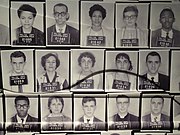
![Roy Wilkins in press conference with Autherine Lucy and Thurgood Marshall, director and special counsel for NAACP Legal Defense and Education Fund]. Autherine Lucy was the first African-American student to attend the University of Alabama who later expelled her.](http://upload.wikimedia.org/wikipedia/commons/thumb/5/5f/Aa_marshallthrgd_lucy_1_e.jpg/180px-Aa_marshallthrgd_lucy_1_e.jpg)